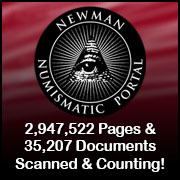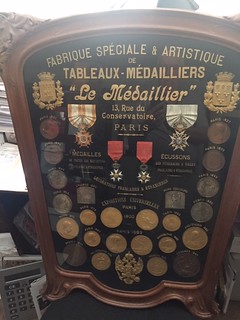
About UsThe Numismatic Bibliomania Society is a non-profit association devoted to the study and enjoyment of numismatic literature. For more information please see our web site at coinbooks.org SubscriptionsThose wishing to become new E-Sylum subscribers (or wishing to Unsubscribe) can go to the following web page link MembershipThere is a membership application available on the web site Membership Application To join, print the application and return it with your check to the address printed on the application. Print/Digital membership is $40 to addresses in the U.S., and $60 elsewhere. A digital-only membership is available for $25. For those without web access, write to: Charles Heck, Treasurer
AsylumFor Asylum mailing address changes and other membership questions, contact Chuck at this email address: treasurer@coinbooks.org SubmissionsTo submit items for publication in The E-Sylum, write to the Editor at this address: whomren@gmail.com BUY THE BOOK BEFORE THE COINSale Calendar |
- WAYNE'S WORDS: THE E-SYLUM JANUARY 29, 2020
- KOLBE & FANNING SALE 155 CLOSES FEBRUARY 1, 2020
- NEW BOOK: VATICAN CITY COINS: 1929-1978
- NEW BOOK: CURRENCY AND CULTURE, VOLUME 1
- NEW BOOK: CURRENCY AND CULTURE, VOLUME 2
- NEW BOOK: COMMERCIAL BANKS IN MODERN CHINA
- ESSAY: RARE NECESSITIES
- DONALD S. HIRSCHHORN (1927-2020)
- JAMES EDWARD SKALBE (1955-2017)
- MINT MEDALS OF FRANKLIN DELANO ROOSEVELT ON NNP
- VIDEO: DANNREUTHER NLG 2019 BOOK OF YEAR
- HISTORIC CHAPMAN CORRESPONDENCE GOES ONLINE
- BORDEAUX EXPOSITION MEDAL EPHEMERA
- NOTES FROM E-SYLUM READERS: JANUARY 26, 2020
- THE CLAIN-STEFANELLIS AT THE SMITHSONIAN
- VOCABULARY TERM: PATINA, PART 1
- DE HAVEN & TOWNSEND
- PLAY MONEY AT WASHINGTON UNIVERSITY IN ST. LOUIS
- CARSON CITY MINT SESQUICENTENNIAL CELEBRATIONS
- POGUE PART VI AND PART VII ANNOUNCED
- LOVE TOKENS AND OTHER ITEMS FROM BOB RHUE
- NUMISMATIC NUGGETS: JANUARY 26, 2020
- WAYNE'S NUMISMATIC DIARY: JANUARY 26, 2020
- COINS HELP WITH BYZANTINE MONASTERY EXCAVATION
- ANCIENT COIN GIVEN TO PUTIN
- SWISSMINT SELLS OUT OF SMALLEST COIN
- BRITAIN'S NEW BREXIT 50P COIN
- THE VALUE OF HANDWRITTEN NOTES ON BANKNOTES
- LOOSE CHANGE: JANUARY 26, 2020
- PEPSI POINTS, REAL MONEY AMD A HARRIER JET
Click here to access the complete archive
To comment or submit articles, reply to whomren@gmail.com
Content presented in The E-Sylum is not necessarily researched or independently fact-checked, and views expressed do not necessarily represent those of the Numismatic Bibliomania Society.
WAYNE'S WORDS: THE E-SYLUM JANUARY 29, 2020
 This week we open with a reminder of the upcoming Kolbe & Fanning numismatic literature sale, three new books, and essay on book collecting, and two obituaries.
This week we open with a reminder of the upcoming Kolbe & Fanning numismatic literature sale, three new books, and essay on book collecting, and two obituaries.
Other topics this week include FDR medals, Chapman correspondence, medal ephemera, notes from E-Sylum readers, play money, the Carson City Mint sesquicentennial, love tokens, the world's smallest coin, and the new Brexit coin.
To learn more about Vatican City coins, the Hangzhou World Coin Museum, the Chase Manhattan Bank Money Museum, coin supply wholesaler Don Hirschhorn, Bordeaux Exposition medals, patinas and patinaeurs, a complete set of 1854-S gold coins, Seward's Cough Cure, Civil War cardboard chits, historic handwriting on banknotes, and the lost coins of Alexander the Great, read on. Have a great week, everyone!
Wayne Homren
Editor, The E-Sylum
KOLBE & FANNING SALE 155 CLOSES FEBRUARY 1, 2020
REMINDER: Kolbe & Fanning's numismatic literature sale will close Saturday February 1, 2020. Be sure to get your bids in. See the earlier articles for some highlights and browse the catalog online - links below. -Editor
Kolbe & Fanning Numismatic Book Sale Saturday, Feb. 1
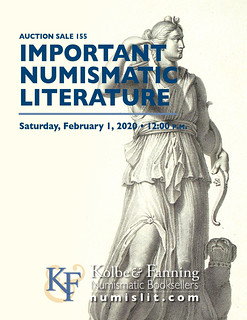 Kolbe & Fanning Numismatic Booksellers are
holding our Sale 155, which will be held on Saturday, February 1, 2020. The 426-lot sale includes a wide-ranging selection of books on ancient, world and U.S. numismatics, including material from the
libraries of Bob Vail, Jeff Peck, Doug Robins and Phil Carrigan. The sale features particularly notable American auction catalogues, along with key references on ancient and world coins, many of them
rarely encountered. The sale may be viewed at bid.numislit.com and highlights can be viewed at numislit.com.
Kolbe & Fanning Numismatic Booksellers are
holding our Sale 155, which will be held on Saturday, February 1, 2020. The 426-lot sale includes a wide-ranging selection of books on ancient, world and U.S. numismatics, including material from the
libraries of Bob Vail, Jeff Peck, Doug Robins and Phil Carrigan. The sale features particularly notable American auction catalogues, along with key references on ancient and world coins, many of them
rarely encountered. The sale may be viewed at bid.numislit.com and highlights can be viewed at numislit.com.
Bids may be placed via post, email, fax or phone, as well as online. Bids placed via post, email, fax or phone must be received by Friday, January 31, the day before the sale, in order for them to be processed. Kolbe & Fanning uses Auction Mobility as our third-party online bidding platform. Auction Mobility is an app-based platform allowing users the ability to participate in the sale through phones, tablets and computers. To register for the sale, bidders must go to bid.numislit.com and sign up. Once you have set up an account, you may browse lots, place advance bids, or participate in the live sale online. Please note that as this is a third-party site, your login information for the main K&F site will not work for the auction site: you need to establish a separate account. Those wishing to participate on their devices can download the Kolbe & Fanning app through the Apple or Google Play Store.
Advance absentee bids may also be placed online at bid.numislit.com; live internet bidding will be available during the sale itself through the same platform. Bidders placing absentee bids will be able to tell immediately whether or not they have the current high bid. Bidders will also receive email notifications when they are outbid before the sale (users of the app may opt to receive push notifications as well).
Kolbe & Fanning Numismatic Booksellers LLC is a licensed and bonded auction firm in the State of Ohio. For more information, please see the Kolbe & Fanning website at numislit.com or email David Fanning at df@numislit.com. To register for the sale, go to bid.numislit.com.
To read the earlier E-Sylum articles, see:
KOLBE & FANNING SALE 155 ANNOUNCED (https://www.coinbooks.org/v23/esylum_v23n02a02.html)
MORE KOLBE & FANNING SALE 155 HIGHLIGHTS (https://www.coinbooks.org/v23/esylum_v23n03a02.html)
NEW BOOK: VATICAN CITY COINS: 1929-1978
Peter Jencius has published a new book on the coins of the Vatican. Congratulations! Here's the announcement. -Editor
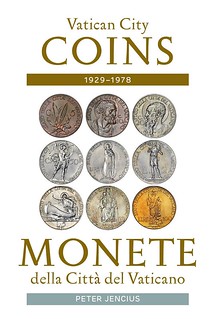
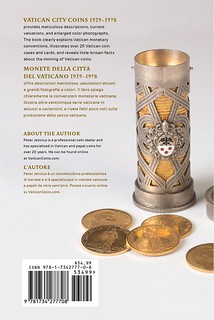
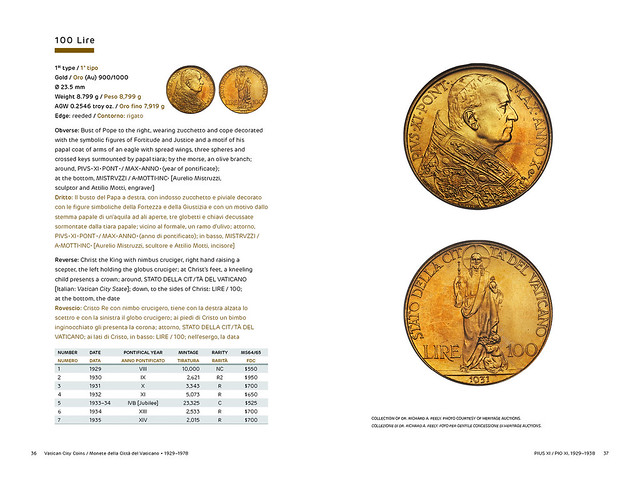
Just published in a print run of only 500 copies, this book is a high-quality, 6" x 9" paperback with a keepsake cover printed on heavyweight paper. (ISBN: 978-1-7342777-0-8)
The book is available for $34.99 at VaticanCoins.com

For more information, or to order, see:
Vatican City Coins: 1929-1978 - NEW BOOK
(http://vaticancoins.com/book/2124/Vatican_City_Coins_19291978__NEW_BOOK/)
Bibliophiles should be sure to check out the complete book section of Peter's web site - in addition to his new book there are a number of great fairly-priced out-of-print numismatic books for sale there relating to the coins and medals of the Popes. -Editor
To browse the two-page inventory, see:
http://vaticancoins.com/books/
NEW BOOK: CURRENCY AND CULTURE, VOLUME 1
In her Chinese Money Matters blog, Helen Wang, Curator of East Asian Money at The British Museum discussed a new two-volume work on Chinese currency and culture. Here's the first volume. -Editor
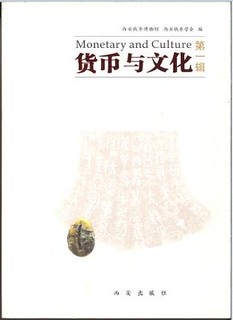 The Xi’an Numismatic Museum (established in
2011) has published the first two volumes in a series in the title Huobi yu wenhua 《货币与文化》. The English title for the first volume is Monetary and
Culture, and for the second volume Currency and Culture. The volumes are jointly edited by the Xi’an Numismatic Museum 西安钱币博物馆 and the
Xi’an Numismatic Society 西安钱币学会. The editor-in-chief is Mr ZHAO Xiaoming 赵晓明.
The Xi’an Numismatic Museum (established in
2011) has published the first two volumes in a series in the title Huobi yu wenhua 《货币与文化》. The English title for the first volume is Monetary and
Culture, and for the second volume Currency and Culture. The volumes are jointly edited by the Xi’an Numismatic Museum 西安钱币博物馆 and the
Xi’an Numismatic Society 西安钱币学会. The editor-in-chief is Mr ZHAO Xiaoming 赵晓明.
Xi’an qianbi bowuguan, Xi’an qianbi xuehui (eds), Huobi yu wenhua / Monetary and Culture, di yi ji (Xi’an: Xi’an chubanshe, 2017). ISBN 978-7-5541-2048-4 // 西安钱币博物馆、西安钱币学会编:《货币与文化》,diyi(西安:西安出版社,2017年)// Xi’an Money Museum and Xi’an Numismatic Society (eds), Monetary and Culture, vol. 1 (Xi’an Publishing House, 2017).
Vol. 1 – Table of Contents
- Foreword – by ZHAO Xiaoming (ed-in-chief) (p.1)
Historic research on Monetary [Research on currency of the past]
- On the "lead cakes with dragon design" unearthed in a Han tomb in Yangzhou (JIANG Baolian, ZHAO Qiang) (6)
- Yuan dynasty silver ingot (Zhending lu Hejian salt-tax) (LI Xiaoping) (13)
- On Western Han "white gold" money (ZHAO Xiaoming) (21)
- On "Liyong tongbao" coins, 17th c (LIU Shunqiang) (26)
- Sales and circulation of late Qing copper dollars (WANG Xianguo) (47)
- On some pre-Qin coins of enfeoffment (DANG Shunmin, DANG De) (54)
- Dating wuzhu coins with rims around the square hole (WANG Taichu) (63)
- The Jianghuai Bank and its notes during the Sino-Japanese War (LI Dong) (70)
- Dragon notes of Shaanxi province during the Xinhai Revolution – five-colour dragon (ZHU Qinghua) (78)
- On the Chuan-Kang Civilians Commercial Bank – Xi'an branch (ZHOU Yanling) (84)
- On gold coins of the Chu state unearthed in Shouxian, Anhui (YUAN Lin) (89)
- On Shaanxi silver ingots (MA Xiao) (92)
- On silver coins cast in Xuantong year 3 (1910) (KOU Shangmin) (104)
- The Qing dynasty coins of Fengtian, with inscription "Bao Feng" (ZHANG Peilin) (112)
- On Tiansheng yuanbao coins, and finds of Xi Xia coins in Wuwei (YU Guangjian, LI Daxiang) (114)
- Two rare boat-shaped silver ingots of the Tang dynasty (WANG Shiyong) (119)
- Copper dollars of Shaanxi (WU Hongwei) (127)
- Notes of the Bank of Taiwan under Japanese occupation (WANG Xiaolong) (132)
- American coins in trans-ocean trade (LIN Nanzhong) (139)
- On Piastres de commerce (trade dollars) (LI Yunheng) (143)
Management of Renminbi
- On the circulation of coins in the Xi'an region (ZHUANG Yibing, CHEN Yaling) (148)
- Management tools and effects of cross-border capital flows based on macro-prudential goals – – the example of Shaanxi province (ZHAO Zihan) (153)
- Thinking about current cash management (QUAN Liyan) (163)
- On RMB anti-counterfeiting cooperation (ZHU Jiang) (167)
- New methods and ways of identifying counterfeits (LENG Xiandan, SUN Yuan, SUN Zhongdao) (170)
- On commemorative coins (LIU Xiaoli) (172)
- Digital money around the world developing in "Chaos and innovation" (ZI Liang) (174)
Monetary Culture Overview
- Kaiyuan tongbao coins in Traditional Chinese Medicine (YANG Huai) (178)
- Qi culture embodied in Qi knife money (CHEN Xu) (185)
- Poetry/songs on German Emergency Currency (notgeld) (LI Chuaming) (189)
- References to money in Chinese poetry (JI Xiaoyong) (195)
- China's traditional money culture: little red envelopes (hongbao) (QIAN Bo) (198)
Museology
- On colour and lighting in museum displays (AI Jing) (202)
- On risk management when in coin galleries (LIU Shunqiang) (206)
- On education in money museums (ZHAO Xiaoming) (211)
- On Internet+ college/university museums (MENG Xin) (218)
- A bridge connecting museums and school education – collaboration between Hanguang Gate Museum and the Bao'en Temple Street Primary School (CHEN Chen) (222)
- Using new media to serve museum visitors – the Jia Pingwa Literature and Art Gallery (WANG Jun) (228)
- The Internet of Things and the Hanguang Gate Museum, Xi'an (HU Yue, WANG Anwen, CHEN Hao) (232)
Tracing of the Silk Road
- The British East India Company Trade and Money – and a discussion on the "Maritime Silk Road" of Zhoushan in the Ming and Qing (SHENG Guanxi) (242)
- Introduction to the "Kerman Khitans" of Western Asia (LIN Wenjun) (254)
- Na Songkhla coins with Chinese inscriptions (HUANG Hansen) (261)
- On coins of the House of Ogedei (WANG Hailin) (268)
- Coins of Iran, ancient and modern (LIU Zhentang) (277)
- The coins of Malaya tell the history of Southeast Asia (LIN Nanzhong) (280)
Walking in Translation [Translations of foreign works]
- Excerpt from Arthur Young's China's Wartime Finance and Inflation, 1937-1945, (tr. FAN Zeyu) (287)
- Excerpt from Jack Belden's China Shakes the World (tr. FAN Zeyu) (289)
Famous Works Appreciation
- Appreciation of Lu Bao's The Money God (QIAN Hui) (294)
- Appreciation of The Classic of Coins (QIAN Hui) (299)
Chamber Introduction [About numismatic organisations]
- Xi'an Numismatic Museum (302)
- Xi'an Numismatic Society (312)
- Research Topics of the Xi'an Numismatic Society in 2016 (316)
Contributions welcome (317)
Contact details:
Mr ZHAO Xiaoming, Xi'an Numismatic Museum, 188 Xi da jie, Xi'an city, Shaanxi province, PR China, 710002
Email: 1041394512@qq.com
To read the complete article, see:
62. THE XI'AN NUMISMATIC MUSEUM'S SERIES "CURRENCY AND CULTURE" (1)
(https://chinesemoneymatters.wordpress.com/2020/01/23/62-the-xian-numismatic-museums-series-currency-and-culture-1/)
NEW BOOK: CURRENCY AND CULTURE, VOLUME 2
In her Chinese Money Matters blog, Helen Wang, Curator of East Asian Money at The British Museum discussed a new two-volume work on Chinese currency and culture. Here's the second volume. -Editor
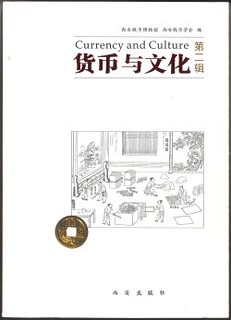 The Xi’an Numismatic Museum (established
in 2011) has published the first two volumes in a series in the title Huobi yu wenhua 《货币与文化》. The English title for the first volume is Monetary and
Culture, and for the second volume Currency and Culture. The volumes are jointly edited by the Xi’an Numismatic Museum 西安钱币博物馆 and the
Xi’an Numismatic Society 西安钱币学会. The editor-in-chief is Mr ZHAO Xiaoming 赵晓明.
The Xi’an Numismatic Museum (established
in 2011) has published the first two volumes in a series in the title Huobi yu wenhua 《货币与文化》. The English title for the first volume is Monetary and
Culture, and for the second volume Currency and Culture. The volumes are jointly edited by the Xi’an Numismatic Museum 西安钱币博物馆 and the
Xi’an Numismatic Society 西安钱币学会. The editor-in-chief is Mr ZHAO Xiaoming 赵晓明.
Xi’an qianbi bowuguan, Xi’an qianbi xuehui (eds), Huobi yu wenhua / Monetary and Culture, di yi ji (Xi’an: Xi’an chubanshe, 2017). ISBN 978-7-5541-2048-4 // 西安钱币博物馆、西安钱币学会编:《货币与文化》,diyi(西安:西安出版社,2017年)// Xi’an Money Museum and Xi’an Numismatic Society (eds), Monetary and Culture, vol. 1 (Xi’an Publishing House, 2017)./p>
Below is my rough translation of the contents into English. For the original Table of Contents in Chinese, see Currency and Culture 2
Vol. 2 – Table of Contents
- Foreword – by ZHAO Xiaoming (ed-in-chief) (p.1)
Historic research on currency
- China's silver money by weight (Jin Deping) (6)
- On Jin dynasty copper plates for paper money WANG Yong) (31)
- The Mongol Empire and coins of the khanates (LI Tiesheng) (51)
- "Qianbi" and "huobi" in historical materials (WANG Jijie) (60)
- On the coins unearthed beneath the Longping pagoda, at the Longzhen site, Shanghai (ZHOU Xiang) (64)
- On the round coins with the inscription Gong tun chi jin (WANG Liyan) (69)
- Computing information on ancient coins – taking Wang Mang's coins as an example (JIANG Baolian, QIN Jianming) (76)
- On the character "jing" on spade money (BAI Qinchuan) (82)
- New research on moulds and casting of Qi knife money (CHEN Xu) (87)
- On Ningbo coin-shops and their account-keeping (SHENG Guanxi) (98)
- On the casting technique of Tang dynasty Kaiyuan tongbao coins (YANG Huai) (108)
- On Qing dynasty silver ingots of Changguan (CHEN Kun) (119)
- On the birth of banliang coins, and different types of banliang (WANG Taichu) (125)
- So many Northern Song dynasty coins, and not a single mother coin? (ZHANG Mailin) (137)
- Stone cowries, and stone discs of the Spring and Autumn, and early Warring States period (TANG Shunde, TANG De) (150)
- The "silver rider" coin (ducaton) in Chinese-Dutch trade (WANG Weili) (157)
- Silver coins piled up high in the Thirteen Hongs – foreign coins in China in the Ming and Qing periods (LUO Wenjing) (164)
- On Shaanxi copper dollars (HE Kangmin) (173)
- How to tell if a silver dollar is genuine or not? (JI Shaoyong) (180)
- Foreign silver coins dominated the Chinese market in the late Qing, early Republic (FENG Jing) (182)
Renminbi research
- On the impact of market-based reform on short-term capital flow based on the VAR model (ZHAO Zihan (190)
- On the past life of Renminbi Series 4 (ZHAO Xiaoli) (203)
- On the three different types of 100-yuan note in RMB Series 5 (YIN Dongfeng, ZHANG Jingtao, SUN Zhongdao) (209)
Monetary Culture Overview
- What are coin-shaped charms? (LIU Chunsheng) (214)
- Commemorative medals as an extension of China's traditional folk coins (ZHANG Deyou) (226)
- On the technique of taking rubbings, and coin rubbings (ZHAO Xiaoming) (234)
Museology
- The cultural value of coin displays in the new interconnected era (BAI Lihua) (250)
- Museums are an important foundation for developing cultural industries (ZHAO Xiaoming) (254)
- On patterns of cultural industry in university/college museums (MENG Xin) (259)
- The relationship between university/college museums and the cultural industries (ZHANG Dongjing) (263)
- The Silk Road cultural values of the Hanguang Gate site (DU Dexin) (267)
- The significance of building museum cultural industries (ZHANG Juan) (272)
- The development of museum cultural industries – the example of the Tang Sancai Art Museum (ZENG Lirong) (275)
- Museum cultural industries and protection of intellectual property (LI Yiming) (280)
- How museum cultural products are developing and the status quo – the example of the Jia Pingwa Literature and Art Gallery (WANG Jun) (283)
Tracing of the Silk Road
- Coins of the Golden Horde (LI Tiesheng) (288)
- Coins of the Western Regions seen in Journey to the West (YUAN Wei) (292)
- The camel trade on the Silk Road of the Steppes as a reference for Belt and Road (SU Lide) (301)
Walking in Translation [Translations of foreign works]
- "Sasanian Coins", by Mrs Elahe ASKARI and Dr Vesta Sarkhosh Curtis, The British Academy Review, Jan-Jul 2001) (tr. CHEN Yaling) (310)
- "Chinese coin found at Kottapatnam, Nellore District, Andhra Pradesh", by K.P. Rao and Joe Cribb, Numismatic Digest (Nasik), vols 23-24 (1999-2001), pp. 133-158. (tr. ZHANG Jiajia) (314)
Famous Works Appreciation
- Appreciation of "Order to drive out illicit coinage" (WANG Yan, YUAN Ye) (318)
- Appreciation of the poem "Ode to Coins" (YIN Fanglin) (323)
Chamber Introduction [About numismatic organisations]
- Hangzhou World Coin Museum (ZHU Jianguo) (326)
- Displaying the wonderful money culture of the Silk Road – the Xinjiang Numismatic Museum (HUANG Zhigang) (331)
- Shandong Numismatic Society (LU Bo) (334)
- Qilu Numismatic Museum (QI Quan) (337)
- The Xi'an Numismatic Museum's survey of portable antiquities in Shaanxi province (QIAN Bo) (339)
Contributions welcome (343)
Contact details:
Mr ZHAO Xiaoming, Xi'an Numismatic Museum, 188 Xi da jie, Xi'an city, Shaanxi province, PR China, 710002
Email: 1041394512@qq.com
To read the complete article, see:
63. THE XI'AN NUMISMATIC MUSEUM'S SERIES "CURRENCY AND CULTURE" (2)
(https://chinesemoneymatters.wordpress.com/2020/01/24/63-the-xian-numismatic-museums-series-currency-and-culture-2/)

NEW BOOK: COMMERCIAL BANKS IN MODERN CHINA
Helen Wang, Curator of East Asian Money at The British Museum also discussed a new book on the history of modern Chinese banks in her Chinese Money Matters blog. With the great rise in interest in Chinese numismatics, those of us in the West should take advantage of the wealth of information to be found in books in the Chinese language. Auction houses and publishers should consider English translations of the more important books. The cataloging and collecting of Chinese numismatic items would be greatly enhanced. -Editor
 Many thanks to Prof Dai
Jianbing 戴建兵 for presenting this book to the Dept of Coins and Medals at the British Museum:
Many thanks to Prof Dai
Jianbing 戴建兵 for presenting this book to the Dept of Coins and Medals at the British Museum:
戴建兵,陈晓荣(编):《中国近代商业银行史》(北京:中国金融出版社,2019年)
DAI Jianbing and CHEN Xiaorong (eds), Zhongguo jindai shangye yinhang shi / The History of Commercial Banks in Modern China (Beijing: Zhongguo jinrong chubanshe, 2019. ISBN 978-7-5220-0143-2
Table of Contents
Introduction (p.1)
Hongkong and Shanghai Banking Corporation (p. 15)
Russo-Chinese Bank (p. 73)
Commercial Guarantee Bank of Chihli (p. 109)
Banque Industrielle de Chine (p. 145)
Bank of Territorial Development (p. 193)
Salt Bank (p. 227)
Zhongfu Bank (p. 267)
Exchange Bank of China (p. 295)
American-Oriental Banking Corporation (p. 325)
Agricultural and Industrial Bank of China (p. 363)
Continental Bank (p. 395)
National Industrial Bank of China (p. 429)
Chinese American Bank of Commerce (p. 473)
Frontier Bank (p. 515)
China and South Sea Bank Ltd (p. 549)
Great Northwestern Bank (p. 587)
Land Bank of China (p. 611)
Afterword (p. 645)
To read the complete article, see:
60. BOOK: THE HISTORY OF COMMERCIAL BANKS IN MODERN CHINA
(https://chinesemoneymatters.wordpress.com/2020/01/21/59-book-the-history-of-commercial-banks-in-modern-china/)
ESSAY: RARE NECESSITIES
Harry Waterson writes:
I would like to bring to your attention a New York Times essay entitled Rare Necessities by Stephen Marche. A very cogent state-of-play on collecting rare books. Some thoughtful quotes. Belongs in the bibliomaniac's ‘current' file.
Thanks, Harry. Bibliophiles, enjoy. -Editor
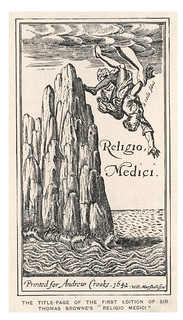 Beneath tight brown paper, inside a bubble-wrapped box, nestled in
plastic foam inside another sealed box, inside a package inside a FedEx envelope, the squat book sat — its plain red cover glowing like a battered ember: the first, unauthorized edition of "Religio
Medici" by the 17th-century physician and writer's writer Thomas Browne. It's mine. I own it.
Beneath tight brown paper, inside a bubble-wrapped box, nestled in
plastic foam inside another sealed box, inside a package inside a FedEx envelope, the squat book sat — its plain red cover glowing like a battered ember: the first, unauthorized edition of "Religio
Medici" by the 17th-century physician and writer's writer Thomas Browne. It's mine. I own it.
I own every Thomas Browne first edition now. I bought them more or less in the order in which I enjoy them, following Browne down the elaborately filigreed labyrinths of his strange obsessions, on subjects as diverse as whether elephants have knees and what species of fish Jesus ate after the Resurrection. First "Pseudodoxia Epidemica," from 1646, Browne's extended debunking of "vulgar errors," then his "Miscellany Tracts," which contains his glorious essay "Musaeum Clausum," perhaps the first English history of lost books. Virginia Woolf described his masterpiece, "Hydriotaphia," a survey of funerary customs, as "a cathedral where the organ goes plunging and soaring and indulging in vast and elephantine gambols of awful yet grotesque sublimity." Probably the most beautiful book, physically, is his "Posthumous Writings" from 1712, with its foldout plates of the Norfolk cathedral. But the unauthorized "Religio Medici" — on the faith of a doctor — was the most expensive of my purchases (about the cost of a month's rent on a one-bedroom in Park Slope), and also the grimiest. It is the equivalent of a 400-year-old bootleg DVD.
The affliction of the vast majority of writers is to know what everyone in the world should buy and never to have any money. To be a writer is to be able to stride into a billionaire's home and critique the gauche fussiness of an ormolu clock over the mantelpiece when you couldn't afford the cut flowers in the powder room. But every writer I know owns at least one object he or she cannot afford but has to have — a vintage YSL jacket, a Linn LP12 turntable, a collection of prisoner-made demon sculptures. For me, it's Thomas Browne. These books are not conspicuous consumption. I don't show them to anybody. They sit in a safe place in my office, where I rarely go. I need them for myself, not others.
To read the complete article, see:
I Can't Afford These First Editions, but I Buy Them Anyway
(https://www.nytimes.com/2020/01/17/books/review/first-edition-rare-books-thomas-browne-stephen-marche.html)
DONALD S. HIRSCHHORN (1927-2020)
David Lange submitted these thoughts on coin supply wholesaler Don Hirschhorn. Thanks. -Editor
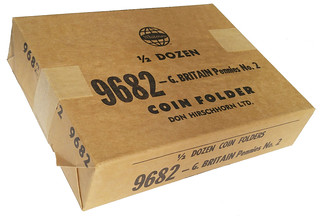 I just learned of the passing of Don Hirschhorn two weeks
ago today. His name is perhaps not so well known recently, but he was a giant in the coin supply business during the 1960s-70s.
I just learned of the passing of Don Hirschhorn two weeks
ago today. His name is perhaps not so well known recently, but he was a giant in the coin supply business during the 1960s-70s.
He was Whitman's biggest jobber (wholesale distributor) throughout the '60s, forming Don Hirschhorn, Ltd., with offices in Wisconsin, Pennsylvania, Massachusetts, Puerto Rico, Canada and the United Kingdom. He even put out a series of Whitman folders under his name as publisher that were distributed solely in the UK and the Republic of Ireland. During the 1970s he broke with Whitman, purchasing the old stamp firm of H. G. Treacher Company and publishing his own line of coin folders under that name or his new Treat brand through 1980. I'm attaching a few images of his many stamp and coin products.

Back when I began my work on producing coin album books and foolishly thought I could cover all publishers in a single volume, I exchanged emails with Don, then retired in the Miami area. More recently, I've been in touch with his wife, Sandra, as Don was experiencing dementia in his later years. I had only recently sent a draft of my biography of Don that is to appear in my book on Whitman products when Sandra notified me of his passing January 12.
There are no specific plans for a memorial, but when I asked Sandra what sort of recognition is appropriate she suggested that Don would have appreciated a donation to the Yad Vashem Holocaust Remembrance Center (www.yadvashem.org). I've done this already and invite others who knew him to do the same.
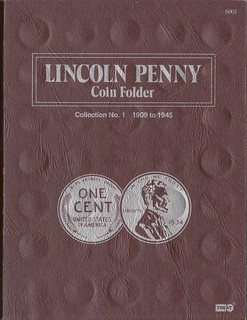
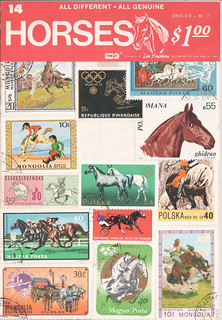
Hirschhorn passed away in New Jersey. Here's an excerpt from his obituary. -Editor
Donald was born in Brooklyn, New York, on August 30, 1927, to Irving Hirschhorn and Bessie Passoff, both immigrants from Russia. He raised his family in Jericho, Long Island before moving to Hawley, PA, where he and his wife, Sandra, designed and built their dream home on a lake, and Boca Raton, FL. They moved to Monroe Township nine years ago.
Donald served as a Technician Fifth Grade for the U.S. Army until 1946. A World War II veteran and member of the Greatest Generation, he was particularly proud of his service stationed at the Panama Canal Zone.
Shortly after graduating from City College in New York, in 1952, he started a business distributing numismatic and philatelic products to retailers. As a boy, Donald was an avid stamp collector; by 1964, he had formed Don Hirschhorn, Inc. with offices in New York, Wisconsin, Pennsylvania, Massachusetts, Puerto Rico as well as Canada and England. By the late 1960's he began publishing his own line of stamp and coin collecting products including prepackaged stamps featuring specific themes, stamp albums and coin folders.
Donald was the proud patriarch of a large extended family and organized various reunions to remind younger generations of the contributions family members had made to the United States. His wise and loving counsel to family members will be greatly missed, as will his steadfast, uncomplaining manner and good humor.
Dave Lange adds:
"I would love to have a period photo of Don, something from 1960-80. Perhaps readers can come up with one."
To read the complete article, see:
Donald Stanley Hirschhorn (https://www.msmc.us/obituary/345079/Donald-Hirschhorn/)
JAMES EDWARD SKALBE (1955-2017)
Pete Smith submitted these notes about James Skalbe in response to Jeff Kelley's request. Thanks. Can anyone add to this? -Editor
For the 2017 ANA Convention, I created an exhibit on the "Worthy Coin Anniversary Medals." I was aware that these medals were created by James E. Skalbe who was an employee of the Worthy Coin Company in 1988. I was also aware that Skalbe punched his name into various old coins and some more recent coins. He was well known as a dealer in Colonial coins and member of C4.
As background for my exhibit, I wanted to learn more about Skalbe. He was affiliated with The Collector's Shop, Inc. between 1991 and 1998. He also worked for Colonial Trading Company after leaving Worthy. I contacted the company and talked with the current owner. He reported that Skalbe died in March of 2017 and the family did not want to announce his death. Another acquaintance indicated that Skalbe had been in poor health in recent years.
There are many websites that pretend to provide biographical and directory information. Such information is frequently not current and otherwise unreliable. One such website gives his date of birth as February 16, 1955. Most such sites give a current address in Winthrop, Massachusetts. None of these sites report his death.
The Social Security Death Index is an excellent source of dates of birth and death. However, dates of death are withheld for three years. That information may become available later this year.
There may be a story behind the family reluctance to announce the death. Without a published obituary, much of his life story will be unrecorded.
Pete adds:"There are several varieties of the Worthy Coin Anniversary medals in copper, silver and gold. Some were overstruck on Morgan Dollars. Some were overstruck on $20 gold pieces. Steven Hayden sold a gold one last week. Attached are images of the gold one I own."
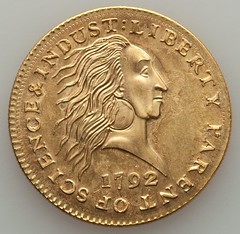
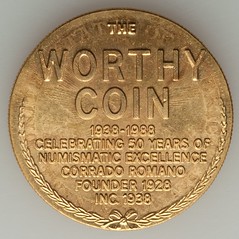
To read the earlier E-Sylum article, see:
NOTES FROM E-SYLUM READERS: JANUARY 19, 2020 : Query: James Skalbe Information Sought
(https://www.coinbooks.org/v23/esylum_v23n03a10.html)
MINT MEDALS OF FRANKLIN DELANO ROOSEVELT ON NNP
The latest addition to the Newman Numismatic Portal is an educational presentation on the medals of FDR. Project Coordinator Len Augsburger provided the following report. -Editor
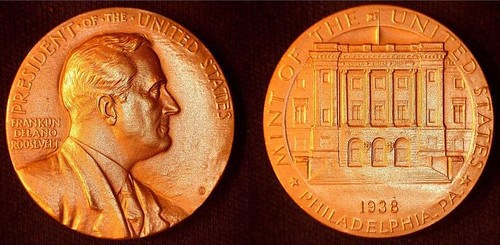
Mint Medals of Franklin Delano Roosevelt
Recently added to Newman Portal is a slide deck presented by Heath MacAlpine at the January 15, 2020 Central Ohio Numismatic Association (CONA) meeting. Franklin Delano Roosevelt was the subject of a surprisingly large number of U.S. Mint medals, and MacAlpine's presentation makes sense of it all, detailing a number of medal series that portrayed Roosevelt. These include the inaugural medals, presidential pieces, assay commission medals, the U.S. Mint visitor medals, and finally the Roosevelt memorial medals.
MacAlpine's die variety analysis of the presidential and memorial series is especially helpful. In all, MacAlpine counts nearly 30 varieties of Roosevelt medals produced by the Mint, and anyone who wishes to collect this material will do well to study the images in this presentation. Newman Portal acknowledges CONA editor Gerry Tebben for his assistance with this content.
Image: Philadelphia Mint visitor's medal featuring Franklin Delano Roosevelt (1938)
Link to The United States Medals of Franklin Delano Roosevelt on Newman Portal:
https://nnp.wustl.edu/library/book/574213
VIDEO: DANNREUTHER NLG 2019 BOOK OF YEAR
These are selections from the David Lisot Video Library that feature news and personalities from the world of coin collecting. David has been attending coin conventions since 1972 and began
videotaping in 1985. The Newman Numismatic Portal now lists all David's videos on their website at:
https://nnp.wustl.edu/library/multimediadetail/522852
Here's one on John Dannreuther winning the NLG 2019 Book of Year Award. -Editor
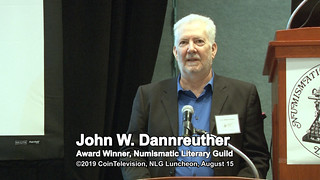 John Dannreuther Wins NLG
2019 Book of Year Award
John Dannreuther Wins NLG
2019 Book of Year Award
An excerpt of the video is available for viewing on the Coin Television YouTube Channel at:
https://youtu.be/XAXwem39TbQ
The Numismatic Literary Guild had a special pre-Awards Ceremony to give its most prestigious honors.
John Dannreuther Wins NLG 2019 Book of Year Award.
Q. David Bowers, Presenter, Numismatic Literary Guild.

HISTORIC CHAPMAN CORRESPONDENCE GOES ONLINE
The Newman Numismatic Portal is also working to digitize an archive of letters to Philadelphia coin dealers S. H. & H. Chapman at the American Numismatic Society. ANS librarian David Hill published an article about the trove in the 2019 Issue 4 of the Society's ANS Magazine. With permission, here is an excerpt. -Editor
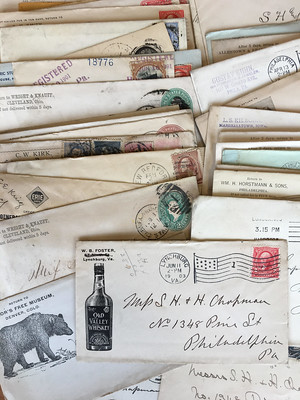 In 1983, the children of legendary coin dealer Henry Chapman Jr. paid
a visit to the ANS. His daughters, Helen, Henrietta, and Jane, and his son, Joseph, came up from Pennsylvania to see an exhibit of materials relating to their father, mostly items they had donated
the previous year. A highlight was the original manuscript, galley proofs, page proofs, and bid book for the celebrated John Story Jenks collection, Henry's "magnum opus."
In 1983, the children of legendary coin dealer Henry Chapman Jr. paid
a visit to the ANS. His daughters, Helen, Henrietta, and Jane, and his son, Joseph, came up from Pennsylvania to see an exhibit of materials relating to their father, mostly items they had donated
the previous year. A highlight was the original manuscript, galley proofs, page proofs, and bid book for the celebrated John Story Jenks collection, Henry's "magnum opus."
When the Society first learned that the family was thinking of making the donation, director Leslie Elam and librarian Frank Campbell wasted no time and went right down to the greater Philadelphia area to meet them. A genial exchange of letters followed, and the whole experience must have left a positive impression on Henrietta, because in 2002, after her death, the Society received a substantial set of early Chapman Brothers correspondence from her estate.
At various times over the years, these letters, now filling about 12 large boxes, have been straightened, organized, alphabetized, and otherwise processed in various attempts to improve access. Unfortunately, as long as the letters were kept in envelopes, they remained difficult to use. Researchers had to guess which ones might be worth looking at, unfold them to find out, and then refold them before moving on.
But now, thanks to work being carried out at the ANS on behalf of the Newman Numismatic Portal, the correspondence is finally being made fully accessible. Lara Jacobs, a technician with the Internet Archive, has not only been rehousing the letters, making them easier to use in person, but has also been scanning and putting them online, where they become instantly available to researchers throughout the world. Lara finds many items of interest as she goes about her work, and I am indebted to her for letting me know about all of the fascinating things that she finds.
The letters mostly begin in 1878, the year Henry Chap- man Jr. and his older brother Samuel Hudson ("S. H.") Chapman started their coin business, and the bulk of them end about the time the two went their separate ways businesswise in 1906.
It's always fun to rummage around and get lost in old correspondence. There are all kinds of interesting things to discover, including photographs. Sometimes it's the little details that transport you to a different time—like when a doctor uses cocaine to treat S. H.'s wife's afflicted toenail.
Sometimes it's the unique characters you encounter, like the vaudevillian Al Emmett Fostell, who wrote to the Chapmans about some medals and other collectibles.
You learn a lot of new things, too, for example that the Chapmans' employed the noted photographer Edward Bierstadt—brother of the Hudson River School painter Albert Bierstadt—to print some of the plates for their catalogs.
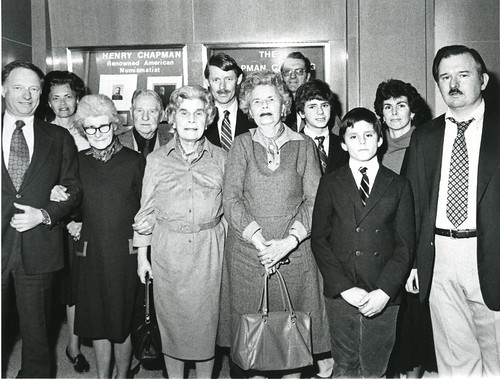
Henry Chapman Jr.'s three daughters and son at the ANS, with family members and Society staff, including librarian Frank Campbell (far right), 1983.
For more information about the American Numismatic Society, see:
http://numismatics.org/
To view letter digitized to date, see:
Chapman (Samuel Hudson & Henry) Archives (https://nnp.wustl.edu/library/archivedetail/516023)
BORDEAUX EXPOSITION MEDAL EPHEMERA
"Patrick McMahon mentioned he had medal #3 on the Bacardi Gold Rum bottle and he had some original paper notes from Le Medaillier M. G. Lagarde in Paris. I have a sales plaque from that company and I was wondering if he would share with your readers the information he has on that insert? I for one would be very interested in what it said."
Patrick's insert appears below with his response. As always, readers can click on the image to see a larger version on our Flickr archive. Just click again to zoom in. -Editor
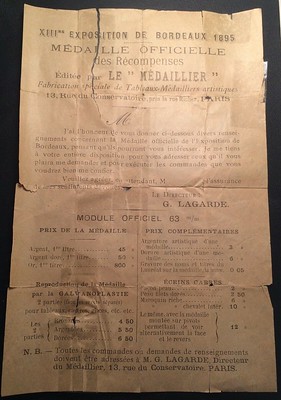 Kudos to Rich! That thing is fantastic. I recognize
it. The E-Sylum published an image of it before I had my slip of paper and I totally missed the connection.
Kudos to Rich! That thing is fantastic. I recognize
it. The E-Sylum published an image of it before I had my slip of paper and I totally missed the connection.
From what I can tell, the firm says they have the honor to give information concerning the official medal of the Bordeaux Exposition and they are at your service to fill any orders you might wish to place. You can buy the medal through them in silver, gilt silver, or gold. I don't know for sure but this suggests to me that what you got was bronze no matter what your award level and you could pay to "upgrade." That seems to be the case in a number of fairs.
It says you can buy galvano reproductions from them for advertisements, have a medal silvered or gilt, or get the name and title of the winner engraved on it (5 centimes per letter). You can buy different types of presentation boxes for it including one of morocco leather with an easel and another with a pivot inside to allow viewing the front and back of the medal.
The paper is cheap and very, very thin and as the image shows: tattered and fragile. It amazes me that it was preserved with the medal the way it was. It has Scotch tape of different vintages holding bits of it together. It was a big part of the reason I bought the medal (which was luckily in much better condition than the paper). Knowing how awards could be customized definitely helps understand the subtle range of differences when you find them. I was very happy to have gotten ahold of a specific list of options for a single Exposition as it was sent to the winners.
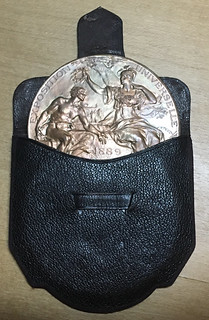 For award medals I am interested in the ephemeral stuff that
can accompany them and I look for them in their original "étuis" (can be any kind of holder, folder, envelope or box--in fact, if you Google the word you will find the definition currently
includes smart-phone cases!). Even a slab can be an étui and Rich's slab is the biggest étui I've ever seen!
For award medals I am interested in the ephemeral stuff that
can accompany them and I look for them in their original "étuis" (can be any kind of holder, folder, envelope or box--in fact, if you Google the word you will find the definition currently
includes smart-phone cases!). Even a slab can be an étui and Rich's slab is the biggest étui I've ever seen!
For fun, here are images of the étui that the 1889 expo medal came in.
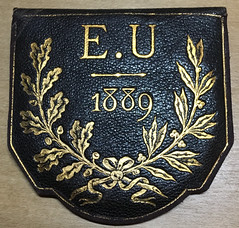
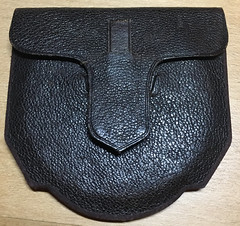
Out of curiosity I tried a search of the Gallica database for the Bibliothèque nationale de France to see if there was any information about Lagarde that could be found quickly and I located just
one easy hit. It is an article from the November 8, 1894 "Bulletin Officiel" for the Exposition Universelle, Internationale et Coloniale in Lyon. According to Wikipedia that's three
days before the Fair closed.
https://en.wikipedia.org/wiki/Exposition_internationale_et_coloniale_(1894)
![Bulletin_officiel_de_l'Exposition_de_[...]Exposition_universelle_bpt6k61566972_1](https://c1.staticflickr.com/1/768/49441807242_440eff2abf_n.jpg)
![Bulletin_officiel_de_l'Exposition_de_[...]Exposition_universelle_bpt6k61566972_2](https://c1.staticflickr.com/1/768/49441578776_83e3e295b0_n.jpg)
Reference: https://gallica.bnf.fr/ark:/12148/bpt6k61566972 .
This is also the fair where French President, Sadi Carnot was assassinated just five months earlier (eventually the subject of Oscar Roty's famous plaquette).
The article is a splashy reveal and celebration of the design for the award medal for the fair. It attributes the inside information to Georges Lagarde, a "compatriot" (of Lyon) and director of "Le Medaillier" in Paris. Since this is promoting their medal it goes into great detail about those responsible for it and gushes about their skills and resumés--specifically Henri-Auguste Patey the sculptor and Georges Lagarde the publisher. About Lagarde, the writer says that he published the music award at the exhibition and that he previously published the medal from the city of Toulon commemorating the visit of the Russian fleet that was distributed to 3,000 Russian sailors (1893--presumably the one by Chaplain) and that it was his "maison" that published the medal for the 1889 Exposition.
The rest is worth a quick digression. Perhaps a French-speaking subscriber to The E-Sylum with specific numismatic knowledge could take a pass at a more accurate translation of the the whole thing? The language is expressive and a bit confusing but the writer goes on and on about all the steps for producing these medals. It describes the sculptor modeling it in plastiline and refining it in plaster. It alleges that there are only one or two in Paris who can produce the "heavy metal coins for the dies" and that they are so secretive they take no students. This is seemingly contradicted by a knowing description of the process of hardening them and how many times they have to be annealed and how long that takes. This appears to be a recurring theme of the whole message--how long each step takes, including the multiple strikes to produce each medal.
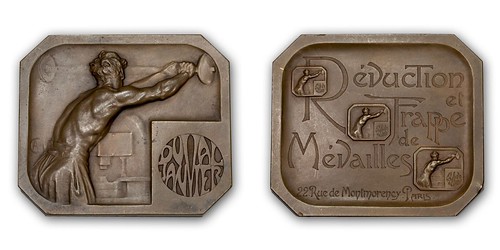
Janvier medal by Charpentier
What is really interesting to me (whether true or not) is the assertion that the preparation of the reductions for the hubs and dies is a complete secret and that only two people in Paris can do it--Tasset and Janvier. The article says that while their systems are different, they are also so secretive that nobody has ever been allowed to visit their studios. But by the end of the decade Janvier is selling his famous reducing lathe and promoting it with that amazing medal by Charpentier.? Near the end the text it says again that the process is laborious and that the slow creation of the works is not appreciated. [My French is rudimentary and I am grateful to my colleague Valentine Lescar for helping me muddle through this!]
Going back to Lagarde--with the information he provided to the writer he promotes himself as the publisher of quite a few important medals, including the 1889 Expo medal by Bottée which I sent an image of last week. Here are some pictures of it in its étui which this article suggests is the work of Le Medaillier like the range of à la carte choices in the slip of paper for the Bordeaux medal.
There is no way I would ever have made this connection without the 1894 Lyon article and the nudge from Richard Jewell that got me to look for it.
The message to everyone here is... even if you have to slab your medals (and you don't)... please don't throw away the soft parts! Those are just as important for connections to the past and telling the unique stories of these objects. ?Some of the participants are invisible without them!
To read the earlier E-Sylum articles, see:
LE MéDAILLIER MEDAL SHIELD (https://www.coinbooks.org/v21/esylum_v21n42a22.html)
MORE ON MEDALS IN ADVERTISING (https://www.coinbooks.org/v23/esylum_v23n03a11.html)
NOTES FROM E-SYLUM READERS: JANUARY 26, 2020
A. Pismo Clam
Joel Anderson's article on modern Pismo Clam Money prompted Frank Robinson to write:
A. Pismo Clam was a character in a W.C. Fields film, "The Bank Dick."
It's true! I looked it up. "Bank Detective" is the safe-for-work term for the old-time moniker. -Editor
To read the earlier E-Sylum article, see:
MODERN PISMO CLAM SHELL MONEY (https://www.coinbooks.org/v23/esylum_v23n03a20.html)
Early Minting Video
Howard Daniel passed along this link to a video about minting from the University of Rare Coins. He'd found it in a Facebook group he belongs to. It uses Flash Player, and may not render in your browser. Mine blocked it, but check it out if you can, and let us know what you think. -Editor
To watch the video, see:
http://urc.universityrarecoins.com/urccontent/wbd/V101_Early-Minting/engage.html
Chase Manhattan Bank Money Museum Pamphlet
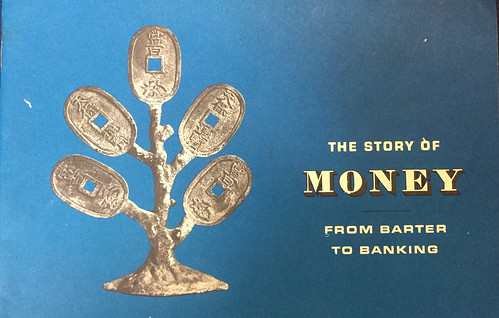
Allen Pauly writes:
As a 15-year-old boy at the New York World's Fair, I was intrigued by the coin display presented by the Chase Manhattan Bank Money Museum. This was pamphlet that was given to us upon entering the display. The pamphlet is 16 pages.
A quick check on Wikipedia shows the museum was in existence from 1928 to 1977 with "most of the collection donated to the National Numismatic Collection at the Smithsonian Institution" and some of collection going to the American Numismatic Society including an 1804 U.S. Dollar.
When I got home to Houston, I put the pamphlet in between some Whitman coin folders and recently ran across it. To run into something that was put away some 56 years ago was quite the trip down memory lane.
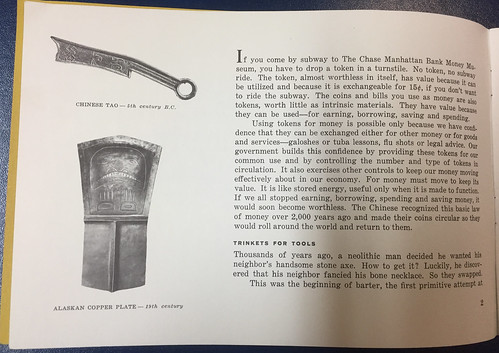
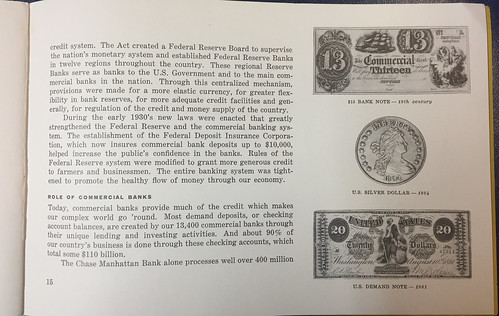
Thanks. The Chase Manhattan museum was a little bit before my time as a collector. I have a copy or two of this pamphlet in my ephemera files, though. -Editor
The Chapman's Photographer
Last week John Lupia's article identified Edward Bierstadt as a photographer who worked for Philadelphia coin dealers S. H. & H. Chapman, a fact confirmed this week in David Hill's article (also based on Chapman correspondence files). I reached out for further confirmation to Dan Hamelberg who owns a number of Chapman plate glass negatives. -Editor
Dan writes:
I checked my Chapman glass negative plates, and I am unable to find any markings or indications of who made the plates or where made. I have the 9 plates from the Jackman Sale, and 9 plates from the Bement Foreign Sale. There is one Jackman plate that has a tag with an address: 1324 Walnut St. - Phila. This is the only marking I can find.
Bierstadt was based in New York. Does that Philadelphia address belong to one of the Chapmans? Or could it be a second photographer? -Editor
To read the earlier E-Sylum article, see:
EDWARD BIERSTADT (1824-1906) (https://www.coinbooks.org/v23/esylum_v23n03a15.html)
Another Gold Medal Product: Martinelli's Sparkling Cider
Phil Iversen writes:
Regarding the article about medals in advertising, I am enclosing two photos on the subject from a product that I enjoy and is cheaper than Bacardi!
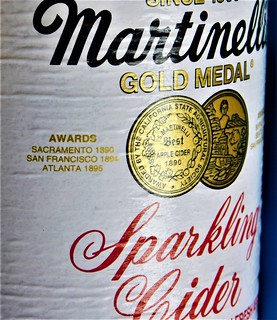
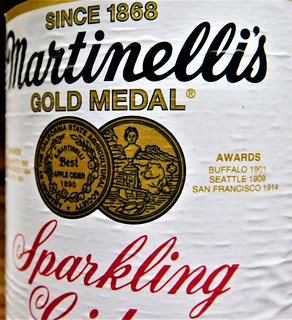
Thanks. Bottoms up! -Editor
To read the earlier E-Sylum article, see:
MORE ON MEDALS IN ADVERTISING (https://www.coinbooks.org/v23/esylum_v23n03a11.html)
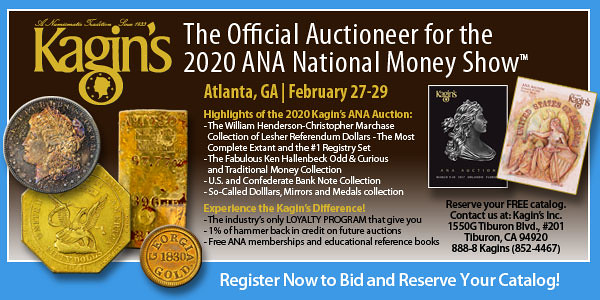
THE CLAIN-STEFANELLIS AT THE SMITHSONIAN
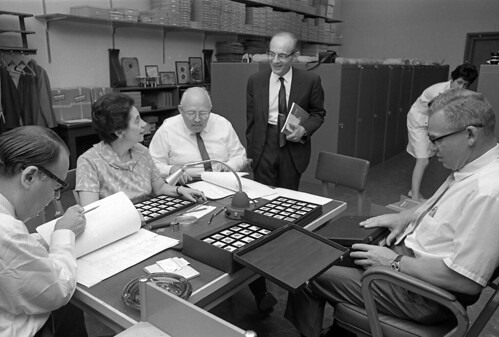
Last week we published the above photo of National Numismatic Collection curator Elvira Clain-Stefanelli, and I asked for help identifying others in the photo. -Editor
Edward C. Rochette Money Museum Director Douglas Mudd (who worked at the NNC at one time) writes:
"The photo has Vladimir Clain-Stefanelli - Elvira's husband - standing in the background - the coins are from the Lilly collection - the boxes are what Josiah K. Lilly stored his collection in. The person seated across from Mrs. Stefanelli could be Abe Kosoff. The person to her right might be Carl Jaeschke who worked with the Stefanellis at SI for many years. Other than Vladimir, I am guessing based on who was working there at the time, and I never met Jaeschke."
Julian Leidman writes:
"Elvira's husband, Vladimir is standing. There is a possibility that the seated figure to the left is Hans Schulman, but it is just a guess. I seriously doubt that the other ID for Abe Kosoff is correct. I am pretty sure that Harvey Stack might be able to help."
OK - we have a consensus that the standing gentleman is Vladimir Clain-Stefanelli. We checked with Harvey Stack and he was unable to make other positive identifications. But he did provide the following remembrance. Thanks, Harvey! -Editor
I saw the feature about Elvira, It made me feel somewhat old, as they remind me of the Stefanellis back when they first worked for Stacks's in the early 1950's. How young both looked. After they went on to the Smithsonian we remained close friends, and we worked together when in the 1960's getting the Congress of the United States to expand the National Collection and acquire by acquisition the Josiah K. Lilly Collection for the National Collection.
Before and after the Lilly Collection we always worked together to get the National collection more donations and help provide funds for further acquisitions.
As you know the Stefanelli's had a small staff until they could finally get some assistance from the Museum. Most of the help they had was private collectors and members of the Stack Family giving their time and effort in developing the National Collection as the most important numismatic collections ever assembled.
Stack's introduced them to many collectors of the 1960 and 1970 period, and the staff was minimal at the time. Many prominent collectors gave their time freely to re-catalog the collection, work in displays and get the collection to grow. We were able to get the Dupont Family, The John L.Roper Family and many others to make contributions and give assistance to them.
I do not remember when you (Doug Mudd) joined the staff, but you and younger numismatists help make them make the National Numismatic Collection grow and gain the prominence they have had and now have as a major Numismatic Collection in the World.
Since I am now 91 years old, recognizing faces other than Elvira and Val is not easy but I believe all that are shown in the Esylum pictures are collectors who worked with them, and not staff. You surely know for all the years you were part of the staff how much work you all did together. It was monumental and a great result for both the Stefanell's and the meager staff with them during your years together.
I do not remember the faces of the others in the photos but I am certain that there has to be a record in the archives of the Museum of any of the staff that they had with them.
All I can say, the two Stefanelli's taught me a lot, when in our employ and all the years we worked together. They were so dedicated to the Museum. During their employment at Stack's in the 1950's, while I was growing up in the field, (having personally started in 1947 full time at Stack's) they both gave themselves of their skills that they made me grow faster and be more efficient in Numismatics.
A unrecorded bit of history: In 1987 the Museum dedicated their national collection as a feature of the history of 200 YEARS OF AMERICAN BANKING, and it was the ONLY TIME, because of the importance of the collection, that on the Opening day, I and my wife Harriet were honored guests, and helpers, and it was the ONLY TIME that the Secretary of Treasury and four previous Secretaries were present at a SINGLE EVENT. That memory will always be with me and my family as we were introduced to all of them, and they expressed their appreciation for the Stack family's dedication and work for the collection.
We have been close since we all first met, and to this day, I and my son Larry, are thankful for having Val and Elvira as teachers, and helpers in making us better Numismatists
To read the earlier E-Sylum article, see:
ELVIRA CLAIN-STEFANELLI AT THE SMITHSONIAN (https://www.coinbooks.org/v23/esylum_v23n03a16.html)
VOCABULARY TERM: PATINA, PART 1
Dick Johnson submitted this entry from his Encyclopedia of Coin and Medal Terminology. It's the first of two parts on an important numismatic topic - patina. Thanks. -Editor
Patina. Surface coloration; any of a variety of finishes that are applied to a metal surface to give it color and protective finish. The term derives from the green finish – incrusted patina – of bronze buried underground. This process, known since ancient times, is a very slow chemical reaction; incrusted patina forms from the copper in the bronze in contact with sulfur in the soil or surroundings to form green copper sulfate. Buried bronze coins and statues give the best evidence of incrusted patina.
Fortunately the two metals most suitable for applying artistic patinas as a modern process are also excellent in casting and striking – copper and silver. Each metal composition, however, will have its own patina requirements. When artificially applied, silver and silver alloys have a narrow range of color patinas, grays and blacks. Copper and bronze have a very wide range of color patinas, predominantly browns and greens.
With extreme skill, however, a patina finisher (a patinaeur) can color bronze any color of the rainbow as well as white and black. Also of importance, if a patina color is unsatisfactory, the piece can be repatinated –the old patina can be removed and/or a new patina can be applied over it.
Patinas add permanent color to a metal surface, give it protection and enhance the beauty of the design. It does not add texture to the surface, nor does it create relief. Patina is not paint, it is not a coating, it is not transparent. Instead a patina will color the top layer of molecules of a metal surface by changing their chemical properties. Thus it is permanent unless the surface is treated with chemicals again.
Patinas for medallic items are the same as those applied to statues. However, since medallic items are comparatively small, their processing can be done on a production line bases and often more varied. Statues are usually one of a kind with larger surface area, and for repatinating must be done on location where the sculpture cannot be removed to a workshop. Medals are processed for patina work in the finishing department of a medal plant and done by the batch process under far more controlled conditions.
Techniques of patina applications. Patinas are not simple immersions of medals in some liquid that magically transforms a raw medal into a colored medallic item, and to dip the medal in another liquid to get a different color (like Easter egg coloring). Instead a patina finish is a combination of the coloring agent – a chemical – and technique of its application plus the skill of the finisher.
Typical patina applications are wet wheel, torch finish, brush finish, immersion finish, appressed finish and vapor finish. Brush finishes have a wide range of applications with the use of different brushes: stipple brush, wire brush, bristle brush, scratch brush and bristle wheel. The chemical can be applied at room temperature, hot, boiling or applied with a blow torch. Application methods differ widely adding to the many variables of these techniques. Detailed descriptions are given in the entries on these patina applications.
Variables affecting patinas. The alloy composition of the metal object to be finished is the foremost variable, followed by the chemical(s) used to effect the color desired; temperatures and time are also major variables in patina work. What metals make up the object's alloy? The tiniest amount of lead or phosphorous in the bronze alloy, for example, will greatly alter the outcome of the applied patina. The pH factor (degree of acidity) of the chemicals is always important in acid patinas. How fresh are the chemicals? Are they full strength, or have they been diluted?
Some patinas require the chemical to be applied to a hot surface, or the chemical itself to be boiling. Is the temperature above a minimum, or does it require a precise degree? How long should the chemical be applied? Should it be applied with a cloth, a sponge, or a brush? Should it be brushed on or stippled? With a bristle brush or wire brush. Does it have to be buffed? With a wet wheel or a crimp-wire wheel? Or does it require the item to be immersed? For a few seconds? Or for several days? Is a single color satisfactory? Or are two or more colors required? How strong must the undercolor be? Does the overcolor have to be translucent?
While extensive experience is required for applying a patina, knowledge of the numerous variables is also required and how to correct an unsatisfactory color. Fortunately most objects can be repatinated until the correct control of variables can be mastered and the desired color can be achieved. A particularly attractive patina process, perhaps developed in secret, is known as a proprietary patina if the developer wishes it to remain secret. But because of the large number of patinas published in Hughes & Rowe (Bibliography T11) it could probably be duplicated by others.
Color samples. An astute artist will want to exercise control over the patina of any medallic item he or she creates. The artist will often want to determine which patina his creations are to receive. Often the artist requests to be shown several proposed patinas – color samples – applied to the first cast or struck items so he can make a selection of the most appropriate patina finish.
Such a selected patina will become a patina standard toward which all produced later will be matched for color control. Even in a batch process, there are so many variables in patina work that no two specimens are exactly alike. Thus the patina standard is the color toward which all those produced are to be matched. (The degree of deviating from that color standard among the entire production run is a decision of the finishing department foreman.)
About 1910 the Gorham Company created a set of sample color panels in an attempt to standardize patina finishes (for small bronze statues). It also served the useful purpose of being able to show these panels to prospective customers to ascertain which patina finish to select that the firm could provide.
Types of patina. After extensive literature research and their own experiments, Hughes and Rowe lists 1,126 possible metal patinas. Of this number they recommended 344 formulas. Of this there are about four dozen that are widely employed by experienced patinaeurs in the art field (for statues and medals). An exact number cannot be stated because so much of what these craftsmen do is either proprietary (fine-tuned to their own needs) or their formulas and applications have not been published.
For numismatic purposes we can examine the patinas in two American art medal series and reveal these patinas and the process for their creation. These series are The Society of Medalists (129 medals) and the Great Religions of the World (18 medals). Here are the names and a typical bronze medal bearing that patina:
Bronze Patinas
Typical Medal Patina Color: SoM GRW
Blue (turquoise). . . . . . . . . . . – Catholic
Bronze, light.. . . . . . . . . . . . #1 Salvation Army
Bronze, light, glossy . . . . . . . . #101
Brown, dark.. . . . . . . . . . . . . #8 Presbyterian
Brown, dark with second color #41 Methodist
Brown, chocolate. . . . . . . . . . . #14 Lutheran
Brown, chocolate with green highlights #11
Brown-gray. . . . . . . . . . . . . . #84 Baha'i
Brown, light with green overcolor . – Islam
Brown, light with silver highlights . #87 Judaism
Brown, light with medium highlights . #83
Brown, mahogany.. . . . . . . . . . . #2
Brown, medium.. . . . . . . . . . . . #5
Brown, russet.. . . . . . . . . . . . #25 Buddhism
Brown with green highlights . . . . #3
Brown, white. . . . . . . . . . . . . – Christian Science
Copper antique. . . . . . . . . . . .#122
Gray-bronze.. . . . . . . . . . . . . #90 Episcopal
Green.. . . . . . . . . . . . . . . . #70
Green-blue. . . . . . . . . . . . . . #73
Green with brown highlights . . . #6
Green, pale.. . . . . . . . . . . . . #85
Metallic bronze.. . . . . . . . . . . #74
Red bronze. . . . . . . . . . . . . . #65
Red-brown, pale.. . . . . . . . . . . #40
Plated patinas.
Goldplate (even yellow).. . . . . . . #20
Goldplate, deep yellow. . . . . . . . #4
Goldplate, reddish (rose gold). . . #17
Silverplate antique.. . . . . . . . . #12
Silverplate, steel gray.. . . . . . . #42
From the above chart one can observe the preponderance of browns and greens for bronze patinas. A wide range of browns are in an experienced patintaeur's repertoire. This is due to the nature of copper and its reaction with common patina chemicals. But it should be noted that a wide variety of other colors can be achieved as well.
Further, that plated items (more so silverplate than goldplate) can be given patinas just as can nonplated items and silverplating is infrequently one of the early steps of a distinctive patina. For example, the patina finish for Issue #42 of The Society of Medalists (by Cecil Howard) was first silverplated then oxidized with liver sulfide.
Looking for the meaning of a numismatic word, or the description of a term? Try the Newman Numismatic Portal's Numismatic Dictionary at: https://nnp.wustl.edu/library/dictionary
Or if you would like a printed copy of the complete Encyclopedia, it is available. There are 1,854 terms, on 678 pages, in The Encyclopedia of Coin and Medal Technology. Even running two a week would require more than 19 years to publish them all. If you would like an advance draft of this vital reference work it may be obtained from the author for your check of $50 sent postpaid. Dick Johnson, 139 Thompson Drive, Torrington, CT 06790.
DE HAVEN & TOWNSEND
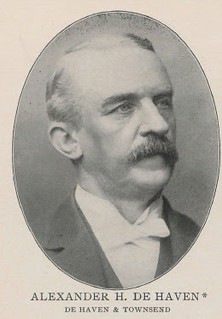 Alexander Henry De Haven (1836-1912), was born on November
1, 1836 at Philadelphia, Pennsylvania, son of Hugh De Haven (1788-1860), and Zipporah Dill White De Haven (1807-1871).
Alexander Henry De Haven (1836-1912), was born on November
1, 1836 at Philadelphia, Pennsylvania, son of Hugh De Haven (1788-1860), and Zipporah Dill White De Haven (1807-1871).
Alexander Henry De Haven and his brother Hugh De Haven ran the banking house of De Haven & Brother at 20 South Third Street, Philadelphia after the death of their father in 1860. Later on renumbered to 40 Third Street.
In 1860, Alexander De Haven married Clara Robinson (1840-1861). She died in childbirth to a son who died in infancy.
In 1864, he married Mary Anne Townsend (1839-1872). Their son Walter Townsend De Haven (1867-1904) became a partner in the family firm.
In 1875, he married Henry Lister Townsend's sister Rebecca Virginia Townsend (1849-1927) at Wilmington, New Castle County, Delaware. They had a son William Brown De Haven (1876-1949)
De Haven & Townsend were a silver money exchange brokerage at 40 South Third Street, Philadelphia when Henry Chapman, Sr., entered the business and may have worked with them. Seeing the profitability in silver exchange besides his tea import business he sent his sons Henry, Jr., and Samuel Hudson to work for John White Haseltine's coin shop to learn the trade. By the date of this circular postal card the Chapmans established their coin trading, antiques and curio firm the previous year and advertised their coin cabinet a modified type caddy for printers invented by an uncle. Whereas the De Haven & Townsend families went on to become major bankers, stock brokers and illustrious notables of finance.
Their circular of January 13, 1879 brings to life the sorry state of U.S. silver currency as bullion depreciated which coin dealers enjoyed getting that slight edge when buying large lots and would cherry pick rare coins having premium values.
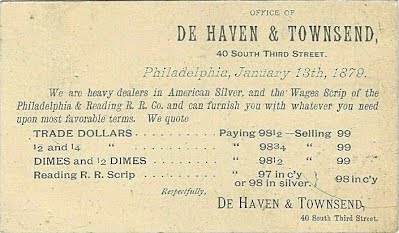
Alexander Henry De Haven (1836-1912) and Henry Lister Townsend (1847-1903) were the partners in their Philadelphia silver and commodities exchange firm. DeHaven had a seat on the New York Stock Exchange. Later on in 1895 their sons Walter Townsend De Haven and Robert Y. Townsend were also partners in the firm. The firm lasted nearly 100 years.
 Walter T. De Haven and the
Chapman Brothers were members of the Cricket Club.
Walter T. De Haven and the
Chapman Brothers were members of the Cricket Club.
Alexander Henry De Haven died at his home in Manhattan on April 16, 1912. His funeral was held at St. Paul's Methodist Episcopal Church West End and his burial in Wilmington, Delaware.
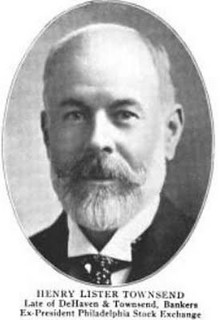 Henry Lister Townsend (1847-1903), was born at Wilmington,
New Castle County, Delaware, the son of Zadock Townsend (1808-1876) and Virginia Rebecca Reynolds Townsend (1808-1878).
Henry Lister Townsend (1847-1903), was born at Wilmington,
New Castle County, Delaware, the son of Zadock Townsend (1808-1876) and Virginia Rebecca Reynolds Townsend (1808-1878).
In 1871 he married Susan Springer Adams.
He died of Bright's disease on January 3, 1903, at Camden, South Carolina. He is buried at Wilmington and Brandywine Cemetery, Wilmington, New Castle County, Delaware.
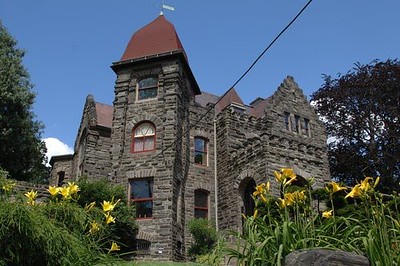
The mansion of Henry Lister Townsend, 6013 Wayne Avenue, built in 1887, is one of Philadelphia's historic homes.
To read the complete article, see:
DE HAVEN & TOWNSEND
(https://sites.google.com/a/numismaticmall.com/www/numismaticmall-com/de-haven-townsend)
PLAY MONEY AT WASHINGTON UNIVERSITY IN ST. LOUIS
Len Augsburger provided this information about a new exhibit on play money at Washington University in St. Louis. Thanks! -Editor
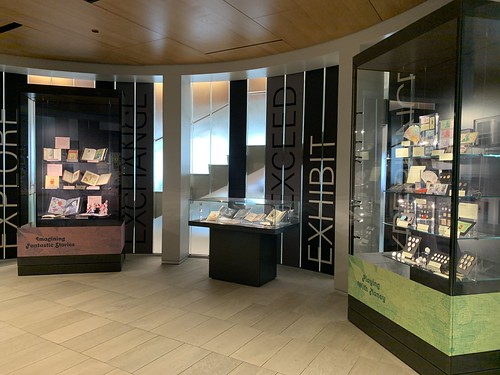
Olin Library at Washington University in St. Louis recently opened an exhibit, Worlds of Imagination, including a case on play money. This exhibit largely draws on material loaned by the ANA and traces play money from the 19th century to the present day. The ANA play money collection was donated in 2018 by Richard Clothier, whose 1985 monograph, Play Money of American Children, explores the subject in depth. The Washington University exhibit, created by Olin Library exhibits manager Jessi Cerutti and Newman Numismatic Portal project coordinator Len Augsburger, runs through June 2020 and is accessible to the public on the ground floor of Olin Library.
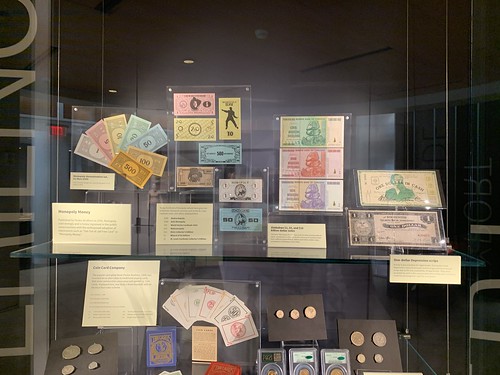
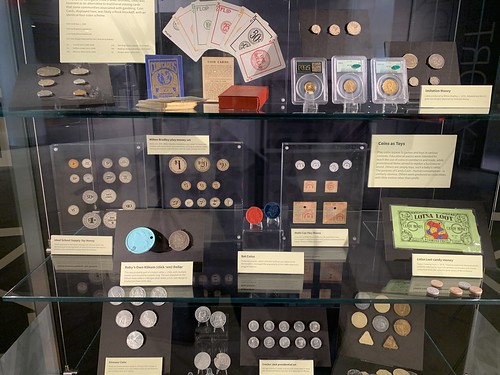
Olin Library acknowledges Doug Mudd and Andy Dickes of the ANA for their assistance with this exhibit, and Richard Clothier, who has made Play Money of American Children available on Newman Portal. Also recommended is the book Playing With Money by Robert Bracey, available through Spink. This volume coincided with the British Museum exhibit of the same name, which ran from April to September of 2019.
Link to Richard Clothier's Play Money of American Children on Newman Portal:
https://nnp.wustl.edu/library/book/569665
Link to Playing With Money on the Spink website:
http://spinkbooks.com/index.php?route=product/product&product_id=630
CARSON CITY MINT SESQUICENTENNIAL CELEBRATIONS
On February 4th, 2020 the Carson City Mint museum will celebrate its sesquicentennial. Here's a short description of festivities from the event web site. -Editor
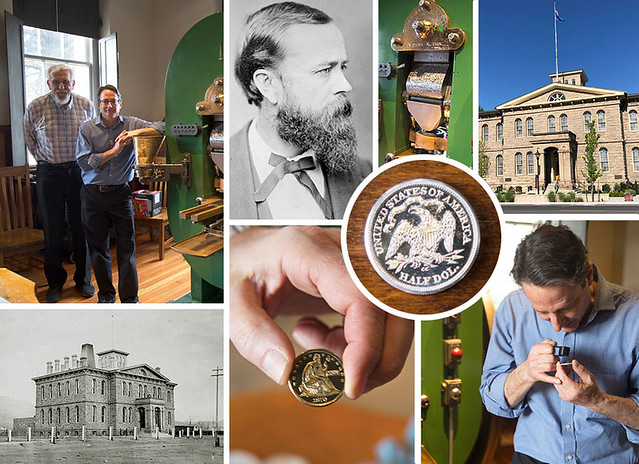
join us on February 4 to celebrate the 150th anniversary of when the Carson City Mint issued its first coin in 1870. Special guests will be on hand to make the ceremonial first strikes on Coin Press No. 1 of a special sesquicentennial .999 fine silver medallion. The medallion dies are sculpted by former U.S. Mint Engraver, Tom Rogers. The medallion honors the rarest minting duo existing on the planet; the CC Mint and Coin Press No. 1.
The day's guest of honor is the director of the U.S. Mint, David Ryder. Director Ryder will kick off the festivities by striking a new sesquicentennial medallion on Coin Press No. 1. The Governor and other state leaders in attendance will also be invited to assist with first strikes. Following the ceremonial minting, there will be a sesquicentennial program featuring Director Ryder as the keynote speaker. A lunch reception sponsored by the Nevada Mining Association follows the program.
For complete information on the celebrations, see:
150TH ANNIVERSARY OF THE CARSON CITY MINT, 1870-2020 (http://mint150.com/)
Are any of our readers planning to attend? Be sure to send us a report - sounds like a great event. The Nevada Appeal published an article chronicling the long journey of Coin Press No. 1 back to its original home. -Editor
The Mint, which issued 57 different types of gold coins and produced eight coin denominations, produced coins from the silver and gold ore of the nearby Comstock Lode. The Mint operated until 1893, producing more than $50 million in coins.
However, the coin press' service was nearly cut short when it suffered a catastrophic failure in 1878.
Rather than send it back to Philadelphia — where it was built by Morgan & Orr — operators opted to send it just up the road to the Virginia & Truckee Railroad.
Mechanics there fixed the press, and, showing a little pride in their work, replaced the original manufacturer's plate with the V&T insignia.
This proved to be a fateful decision nearly a century later.
When the Carson City Mint closed in 1899, the press was shipped back to Philadelphia and converted from steam-powered to electric.
Coin Press No. 1 was then shipped to the San Francisco Mint in 1945. In the 1950s, it was deemed outdated and was set to be scrapped.
However, Frederick Monteagle, then-city editor of the Oakland Tribune, and a Carson City Mint enthusiast, recognized the V&T builder's plate.
He contacted the Nevada State Museum's board of directors, who bought Coin Press No. 1 back for $225.
While the press was back in its rightful home, it was not operational.
That was remedied during a national coin shortage in 1964 when Eva Adams, the director of the U.S. Mint — also a native Nevadan — reached out to the museum to borrow Coin Press No. 1.
The press was sent to Colorado for use at the Denver Mint.
In 1967, the press was once again returned home to Carson City, and in 1976 museum officials used it to mint a commemorative medallion in honor of the country's bicentennial.
Since then, it has produced scores of commemorative medallions.
"I contend it's the most significant and most unique coin press still in operation in the United States," said Bob Nylen, curator of History at the Nevada State Museum.
Festivities will start just before 10 a.m. on Tuesday, Feb. 4 at the Nevada State Museum, 600 N. Carson St. Admission is free.
The commemorative medallion will pay tribute to the Mint building; its first superintendent, Carson City founder Abe Curry; and its first press, Coin Press No. 1. They will be cast in both silver and copper and carry the famous "CC" mint mark.
The Mint Sesquicentennial medallions will sell for $75. Attendees can purchase a blank planchet and have it minted on the coin press.
To read the complete article, see:
Teri's Notebook: Carson City Mint celebrates 150 years
(https://www.nevadaappeal.com/news/carson-city/teris-notebook-carson-city-mint-celebrates-150-years/)

POGUE PART VI AND PART VII ANNOUNCED
Here's the press release for the next two parts of the D. Brent Pogue Collection. -Editor
Stack's Bowers Galleries is pleased to announce Part VI and Part VII of the now legendary D. Brent Pogue Collection. The Pogue Collection will forever be known as an incredible assembly of the very finest early American coins from 1792 through the 1830s. The five sales already completed featured this portion of the collection, almost to completion, with notable additions such as the fabulous collection of $3 gold coins. Those apparent outliers were a foreshadowing of the upcoming sale scheduled for March 18-20, 2020, in Baltimore, Maryland.
Part VI of the D. Brent Pogue Collection will showcase his marvelous paper money collection comprising approximately 230 notes encompassing the areas of large size type notes, small size type notes and National currency. Many of the notes in the collection are among the finest examples known for their types. The collection was also assembled with an appreciation for serial number 1 notes and rare "Star" replacement notes.
Among the monumental notes in the collection is the single finest graded $100 "Baby Watermelon Note." The Fr.377 1890 $100 Treasury Note is graded Choice Uncirculated 63 EPQ and sits atop the PMG census as the only uncirculated example of the type. In addition to the 1890 $100, the cabinet also includes the second finest PMG graded Fr.376 1891 $50 Treasury Note, designated Choice Uncirculated 64 EPQ.
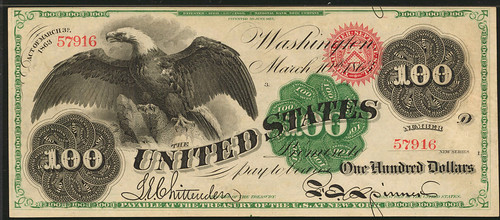
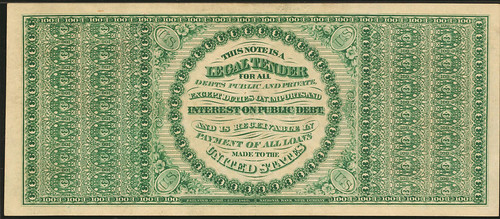
The finest known "Spread Eagle" 1863 $100 Legal Tender Note will also be offered in the D. Brent Pogue Collection sale, an Fr.167a graded Gem Uncirculated 65 EPQ. It is one of just two notes from all three Friedberg numbers that PMG has graded in the uncirculated range. A Fr.342 1880 $100 Silver Certificate from the collection is graded Gem Uncirculated 65 EPQ and is the finest PMG graded example of the catalog number, as well as the finest of the type, which encompasses four different catalog numbers. The collection also includes the only PMG certified uncirculated large size $500 Gold Certificate, a Fr.1216b 1882 $500 Gold Certificate that has achieved the lofty grade of Gem Uncirculated 65 EPQ.
Additionally, the D. Brent Pogue Collection contains two remarkable First Charter National Currency notes from the First National Bank of Lincoln, Illinois, Ch. #2126. The pair is made up of a serial number 1 Fr.449 1875 $50 and a serial number 1 Fr.462 1875 $100, both graded PMG About Uncirculated 55. They represent the only First Charter serial number 1 $50 and $100 notes known to exist.
Part VII of the D. Brent Pogue Collection continues with other coin series which Brent collected quietly for his own enjoyment. This sale presents these areas of interest and displays far more diversity than has come to be expected from this collection. It is an exciting opportunity for collectors who desire this important American provenance, but found many Pogue coins financially out of reach. This sale includes pieces worth from hundreds of dollars to millions—truly something for everyone! Still, the one guiding principle that will be evident in this presentation, as it was in prior Pogue offerings, is a commitment to quality.
Rare American historic medals make a small appearance, led by a pair of prized Libertas Americana medals, one in silver and one in bronze. The inclusion of these in the Pogue Collection points to an appreciation of history and medallic art as well as pure numismatics.
The coins range widely from small selections of superb half cents, led by a Red and Brown 1796 With Pole in MS-66, to small cents including affordable classics such as a 1909-S V.D.B. cent graded MS-66RB (PCGS). Even a modern 1960 Small Date cent graded MS-67RD (PCGS) is included! These are the beginnings of a basic type set, and representatives of many denominations are included. Thus, two-cent and three-cent pieces, half dimes, nickels, dimes and twenty-cent pieces follow. In each category, classic rarities will be found, as will basic type coins such as 1916 dimes, both Philadelphia and Denver issues in superb condition.
With United States quarters, the dynamic changes, as this was clearly a Pogue favorite. Following a small selection of Liberty Seated pieces comes one of the most fabulous collections of Barber coins ever seen, truly special for its extraordinary quality as well as its aesthetic appeal. The collection is visually stunning, loaded with magnificent rarities, and even includes the occasional duplicate; there are two examples of the 1901-S, one MS-66+ (PCGS) and one MS-67+ (PCGS).
The offering of Standing Liberty quarters is extensive, though not quite complete, and includes coins in a wide range of value from a 1929-S in MS-66+ (PCGS) to the famous 1918/7-S overdate in MS-65 (PCGS). Washington quarters follow, with a collection that, like the Barber quarters, is visually impressive and of exceptional quality, with spectacular toning found throughout. All are graded by PCGS and with rare exceptions are ranked as MS-66 or MS-67.
For half dollars and dollars, partial type sets feature high-quality coins, examples of which run the gamut from a 1964-D Kennedy half dollar in MS-66+ (PCGS) to an 1804 silver dollar. "An 1804 silver dollar?" one might ask with surprise. YES! The Pogue Collection included three examples of this most famous American coin. In this sale, Stack's Bowers Galleries is pleased to once again offer the famous Garrett specimen of this American treasure! As famous as this coin is, it is but one of the highlights of this landmark sale.
Gold coins deliver even more important properties, with small selections of each denomination from gold dollars to double eagles. These begin with an 1849 gold dollar graded MS-67 (PCGS), and close with a 1927-S Saint-Gaudens double eagle graded MS-67 (PCGS). In between there are quarter eagles (including an 1841 Little Princess graded Proof-64 Cameo), a $3 piece (an 1878 graded MS-67 by PCGS), a $4 piece (an 1879 Flowing Hair graded Proof-66 Cameo by PCGS), $5 coins (including a 1911-S in PCGS MS-66) and both the Wire Rim and Rolled Rim Indian eagles, each graded MS-67 by PCGS. With all this, the highlight is yet to be mentioned!
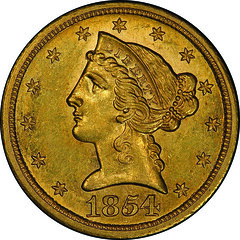
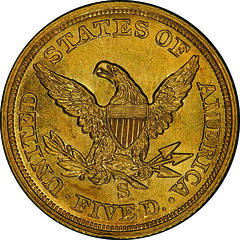
One of D. Brent Pogue's most prized accomplishments was his complete set of 1854-S gold coins. Like the rest of this sale, even this group represents great diversity in value, ranging from the 1854-S $10 in AU-58 (PCGS), to one of the rarest coins in the entire American series, the finest known example of the legendary 1854-S half eagle! From the first Pogue sale to today, THIS is the coin many have been waiting to see, and it will not disappoint! It is stunningly attractive and graded AU-58+ by PCGS. It has not been offered publicly since the October 1982 sale of the United States Gold Coin Collection, formed by Louis E. Eliasberg, Sr. Just 268 examples were struck, and this is the very best of the tiny group that survive today.
Rounding out Part VII are some important pattern coins, including famous types such as a Gem Shield Earring quarter graded Proof-65+ (PCGS), a Schoolgirl dollar graded Proof-65 (PCGS), a Washlady half dollar graded Proof-67 Cameo (PCGS), and an 1852 Ring dollar in gold graded Proof-65 by PCGS.
The D. Brent Pogue Collection Part VI, Masterpieces of United States Paper Money will be offered on the evening of Thursday, March 19, 2020 at the Stack's Bowers Galleries Official Auction of the Whitman Coin & Collectibles Spring Expo. It will be followed on Friday evening, March 20, 2020, by The D. Brent Pogue Collection Part VII, Masterpieces of United States Coinage.
LOVE TOKENS AND OTHER ITEMS FROM BOB RHUE
Bob Rhue shared these images of some interesting items he'd recently obtained. Thanks! -Editor
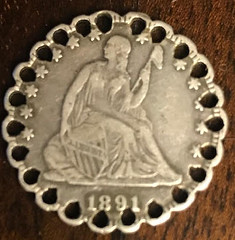
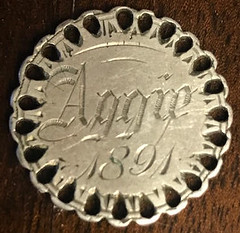
A rather ornate love token on an 1891 25c
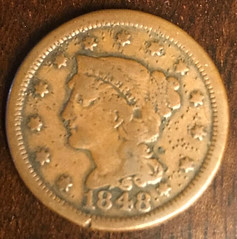
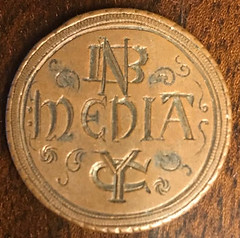
A ‘love token' of sorts on an 1848 Large Cent which seems to read: NBC Media NY (does anyone out there have any information on this?)
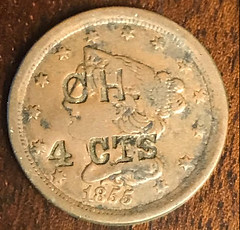
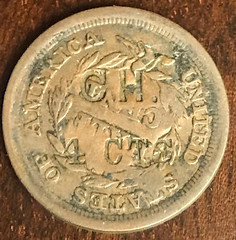
A 1/2c countermarked ‘C H. 4 cts' on both sides. (Any speculation on what was intended here?)
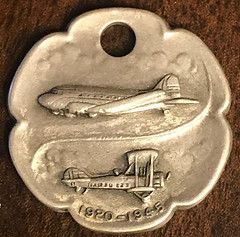
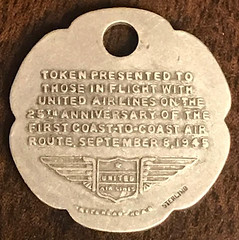
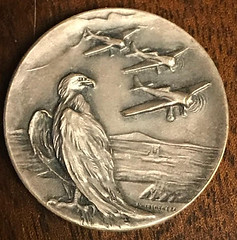
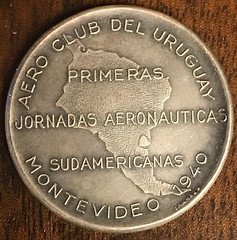
A pair of 1940's era airplane related silver medals with appealing pictorials.
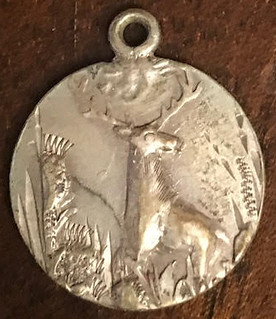
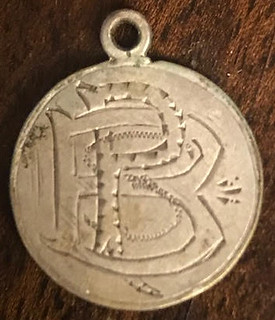
A love token with an animal/nature scene.
What do readers think of these? I like the aviation medals, particularly the United Airline commemorative. "NBC Media NY" evokes broadcasting emanating from Rockefeller Center, but doesn't make sense stamped on an old cent. Is "Media NY" a place? I couldn't find such a town. -Editor
NUMISMATIC NUGGETS: JANUARY 26, 2020
Here's a selection of interesting or unusual items I came across in the marketplace this week. Tell us what you think of some of these. -Editor
Charles I Halfpound
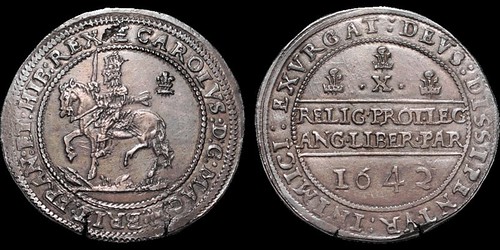
Charles I. 1625-1649. AR halfpound. 60.27 gm. 47 mm. Plume i.m. Oxford mint. 1642. King on horseback left (Shrewsbury horseman), trampling arms on ground; Oxford plume behind; CAROLVS D G MAG BRIT FRAN ET HIB REX / RELIG PROT LEG ANG LIBER PAR (declaration) in two lines across center, •X• and three Shrewsbury plumes above, 1642 below; DEVS DISSIPENTVR INIMICI EXVRGAT around. S. 2944. N. 2403. Morrieson A/1. Extremely Fine; king's head double-struck yet bold; small flaw by mintmark on obverse; two small striking splits around 6'; beautiful tone, surfaces, and strike (from an NGC AU55 Wings holder). Choice.
Ex J C S Rashleigh Part III (Glendinning, June 1953, lot 257, plate XII).
Ex Goldbergs Auction 96 (14 February 2017) lot 2912, ($7500 all in).
(Formerly NGC AU55 Wings, 4437735-006.)
From the upcoming Davisson's E-Auction 34, Lot 71. -Editor
To read the complete lot description, see:
Impressive Halfpound - Ex J.C.S. Rashleigh (https://davcoin.com/lot/e-auction-34-lot-71)
Seward's Cough Cure
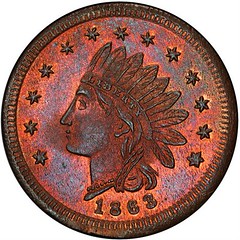
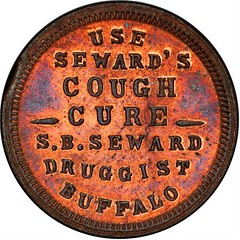
Civil War token Fuld NY105P-1a R5 PCGS MS66 RB with 60% original red mint luster and very nice cartwheel luster. Use Seward's Cough Cure S. B. Seward Druggist Buffalo 1863 with Indian head reverse. From the Q. David Bowers, Rich Rossa and George Fuld collections in a special PCGS holder with Dave's picture and facsimile signature.
Perfect for cold & flu season. From Steve Hayden's site. -Editor
To read the complete lot description, see:
NY105P-1a Buffalo New York Druggist Civil War Token PCGS MS66 RB
(https://www.civilwartokens.com/Listing/Details/2873407/NY105P1a-Buffalo-New-York-Druggist-Civil-War-Token-PCGS-MS66-RB)
1966 Bank of Scotland 100 Pound Banknote
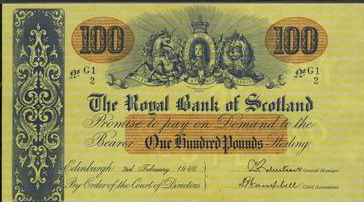
Royal Bank of Scotland. 100 Pounds. 3 February 1966. RB 62f, P-320c. No. G 1 /2. G.P. Robertson, General Manager; A.G. Campbell, Chief Accountant. Blue and orange-brown. Rare.
From the SPINK 30 January, 2020 sale of the Omar Waddington Collection of Banknotes. -Editor
To read the complete lot description, see:
ROYAL BANK OF SCOTLAND. 100 POUNDS. 3 FEBRUARY 1966. RB 62F,
P-320C. NO. G 1 /2. G.P. ROBERTSON... (https://live.spink.com/lots/view/4-9BHJN/royal-bank-of-scotland-100-pounds-3-february-1966-rb-62f-p-320c-no-g-1-2-gp-robertson)
The Story of the Welsh Pound
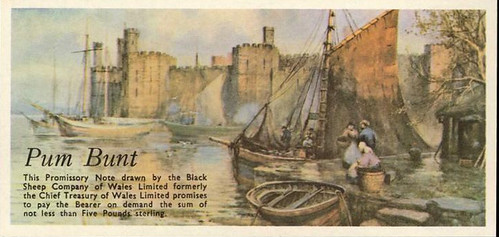
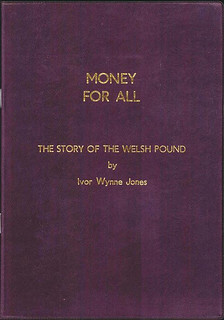 Money For All. The Story of the Welsh Pound, by Ivor
Wynne Jones. Book and Two Banknotes. Great Condition.
Money For All. The Story of the Welsh Pound, by Ivor
Wynne Jones. Book and Two Banknotes. Great Condition.
3 pieces in lot. Includes one book and two banknotes. A scarce book titled "Money For All - The Story of the Welsh Pound" by Ivor Wynne Jones that discusses the lengthy history of the Welsh Pound. Included are two Black Sheep Company of Wales Banknotes. 1 is a Bum Swllt (Five Shillings) issued note with a Treasury Stamp and the other is a Bum Punt (Five Pounds) note. This lot is an excellent collectors piece particularly for those with an affinity for Welsh Banknote history.
For bibliophiles, here's a nice book from the internet portion of the recent Stack's Bowers 2020 NYINC sale. -Editor
To read the complete lot description, see:
Money For All. The Story of the
Welsh Pound, by Ivor Wynne Jones. Book and Two Banknotes.
(https://auctions.stacksbowers.com/lots/view/3-L98MO/money-for-all-the-story-of-the-welsh-pound-by-ivor-wynne-jones-book-and-two-banknotes-great-condition)
The Plastic Tokens of Eastern Pennsylvania 1942-1972
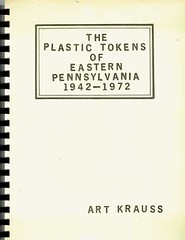 Slight wear. Thick card cover
and text pages in new plastic comb binding.; Undated, circa 1972. Copied type-script single-sided pages. "A need exists for a catalog listing the Plastic Tokens of Eastern Pennsylvania,
including their identification, location, color, size and shape. . I have listed all the Plastic Tokens seen by me from the Eastern part of Pennsylvania by the simplest method possible. By listing
them alphabetically by the letters as they appear on the obverse (front) of the token, I have eliminated the need for an index. Since there are only 4 basic shapes and 5 distinct colors, the
identification and cataloging has been made very simple." - The Catalog. Reference listing of plastic tokens used in the food and beverage trade in eastern Pennsylvania. ; v, 91 pages.
Bookseller Inventory # 13811
Slight wear. Thick card cover
and text pages in new plastic comb binding.; Undated, circa 1972. Copied type-script single-sided pages. "A need exists for a catalog listing the Plastic Tokens of Eastern Pennsylvania,
including their identification, location, color, size and shape. . I have listed all the Plastic Tokens seen by me from the Eastern part of Pennsylvania by the simplest method possible. By listing
them alphabetically by the letters as they appear on the obverse (front) of the token, I have eliminated the need for an index. Since there are only 4 basic shapes and 5 distinct colors, the
identification and cataloging has been made very simple." - The Catalog. Reference listing of plastic tokens used in the food and beverage trade in eastern Pennsylvania. ; v, 91 pages.
Bookseller Inventory # 13811
Here's another book, a scarce self-published volume found on AbeBooks. -Editor
To read the complete lot description, see:
The Plastic Tokens of Eastern
Pennsylvania 1942-1972 (https://www.abebooks.com/servlet/BookDetailsPL?bi=30549832854&clickid=3Ko3-BxPMxyOUGjwUx0Mo38SUknTSN1J33LrTQ0&cm_mmc=aff-_-ir-_-409740-_-439350)
WAYNE'S NUMISMATIC DIARY: JANUARY 26, 2020
Tuesday, January 21, 2020 was the first meeting of the new year of my northern Virginia numismatic social group, Nummis Nova. I was the host and had chosen Ristorante Bonaroti in Vienna, VA. We'd been there in June. I liked that they could provide us with a separate room at no extra charge, which is nice for a raucous, talkative group like ours.
When I arrived a number of folks were already seated including Wayne Herndon, Jon Radel, Mike Packard, Chris Neuzil, Dave Schenkman and Eric Schena. While I was talking Julian Leidman magically appeared at the other end of the table, and I walked over and chatted with him, Robert Hoppensteadt and Wayne for a bit. Back at my seat I was next to Chris and across from Eric and Steve Bishop.
The waitstaff were attentive and served up drinks, bread and appetizers while we talked and perused our menus. I ended up ordering manicotti, a dish I hadn't had in some time.
I hadn't brought any display items this month, but many others were going around the table already.
Great Bronze of Tarsus
Robert Hoppensteadt collects some great ancient coins, specializing in those depicting ancient buildings and monuments. He passed around this bronze of Tarsus. Here are the images and description
from the seller Dorotheum.
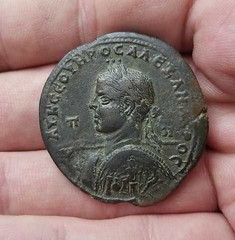
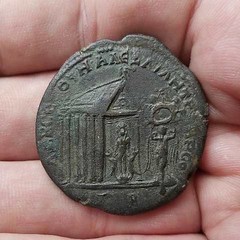
"Tarsus, Cilicia. Great bronze) (40mm 24.07 gr. Av: gr. Leg. AY K SEOYEROS ALEXANDROS, Bust of the laurel-crowned Emperor l. wearing cuirass, holds lance and big shield. On the shield: Athena on Cuirass l. sitting, throws something in a large round vessel and holds a lance. In front of her altar or pillar, behind her the river god Kyndos resting with cornucopia. i. F. l. and r. "Pi". Rv: gr. Leg. ADR SEOYE ALEXA METR TARSO // (Gamma) B, temple of Apollo with six pillars, with a statue of Apollo Lyceus holding two wolves on the front paws, on roof of the temple Nike with wreath, in the gable a garland. On the right, in front of the perspective temple Nike, holding the wreath of the high priest of Cilicia, who in turn is crowned by a small Nike. The wreath of "Ciliarchen" has attached heads of Roman rulers. Missing in BMC, SNG Aulock, SNG Cop. and larger collections. Extremely rare CNG Mail Bid Sale 66, 1195, (19.05.2004.) SNG Levante Suppl. 275 * (same dies.) SNG Fitzwilliam 5333 * (same dies.) "
Civil War Cardboard Scrip
Dave Schenkman passed around a great group of Civil War cardboard chits. He writes:
"Below are images of one of the cardboard chits I passed around at the dinner. The set of five denominations was sold as lot 1399 in the 1985 Bowers and Merena sale of the David Proskey collection of Civil War Era Cardboard Money.
"In the Proskey sale there was another lot of three round cardboard tokens from a different merchant in the same town; I have them also. And, there was a third lot of cardboard attributed to Naperville, consisting of five denominations from a merchant named A. C. Yundg. They weren't illustrated, and the catalog description only has the name. I couldn't find that name in any directory, but they were manufactured by a CW printer.
"I wondered if possibly the cataloger had misspelled the name. Sure enough, I found the man; his name was A. C. Yundt, a merchant in Naperville who, in 1864, became overly friendly with a friend's wife, and she died from a botched abortion. It made the Chicago newspapers."
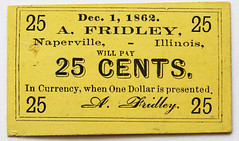
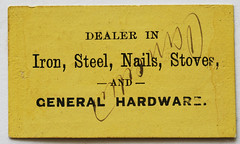
I had also purchased some cardboard scrip in that David Proskey collection sale. I resold them along with my U.S. Civil War collection through American Numismatic Rarities in 2006. Here's the
catalog as digitized by the Newman Numismatic Portal:
https://archive.org/details/lakemichiganspri2006amer/page/130/mode/2up
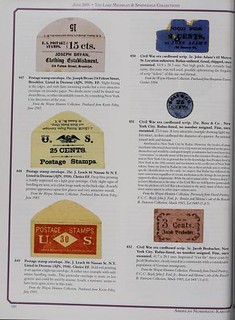
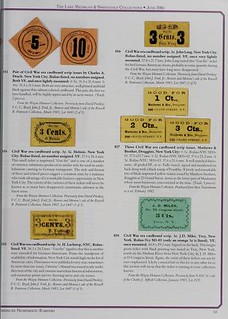
Antebellum Farmer's Bank of Virginia Ledger
Eric Schena and I discussed recent and planned additions to the Newman Numismatic Portal. I invited Eric to lend for digitization his Board of Directors meeting minutes book from the Winchester
branch of the Farmer's Bank of Virginia. It covers the years from 1845 to 1849. He'll bring it next month and I'll ship it to St. Louis for scanning into NNP. I learned from Eric that
pre-Civil War bank records from the South are rare today because so many were burned or lost in the war.
Active Interest Media
Another topic of conversation at the dinner was AIM, the new owner of the former Krause Publications periodicals. I promised to reach out to Tom Michael, and later he provided this report:
"We have been doing very well with Active Interest Media. They have been supportive of our ideas to build NN, WCN, Coins Mag and BNR. [That's Numismatic News, World Coin News, Coins magazine and Bank Note Reporter - Editor] AIM is happy to have us continue building out the database so we are adding new listings on a regular basis and hope to make this data available soon.
"We catalogers are now also involved in the magazine content generation. I have been writing articles for WCN and general online use. Coin of the Year awards are also supported by AIM and we are set to travel to the World Money Fair next week for our awards ceremony set for February 1st. Keep an eye on our Facebook page under Krause Publications for updates through the Fair as Maggie Judkins and I meet with mints and distributors, explore the Fair and present the COTY awards on Saturday.
"Thanks for your and your Virginia dinner group's concern for all us old KPer's! Keep in touch."
It's good to hear the new owners are supportive and planning to move forward. We'll look forward to future developments. Here's a link to the KP Facebook page:
Krause Publications Numismatics (https://www.facebook.com/kpnumismatics/)
Bishop's Beauties
Steve Bishop shared these images of his display items which included two nice plaques, a beautiful Morgan dollar, and a Columbian Expo medal in the largest slab any of us had seen. Thanks.
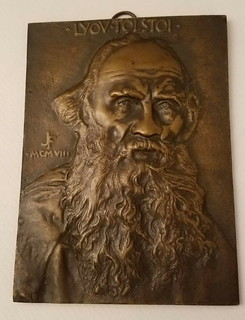
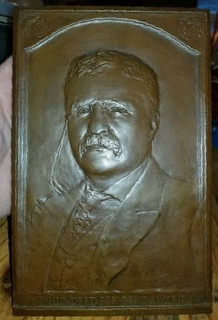
LEFT: Leo Tolstoy Plaque by Flanagan
RIGHT: Teddy Roosevelt 100 Per Cent American Plaque
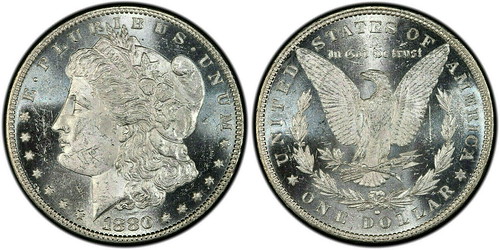
1880-O 80 over 79 Vam-4 Crossbar Morgan Dollar
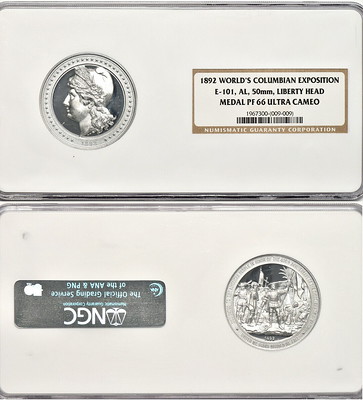
World's Columbian Exposition Liberty Head Medal

COINS HELP WITH BYZANTINE MONASTERY EXCAVATION
Arthur Shippee passed along this article found via The Explorator newsletter about numismatic evidence involved in the discovery of the first Byzantine monastery ever found in Spain. Thanks. -Editor
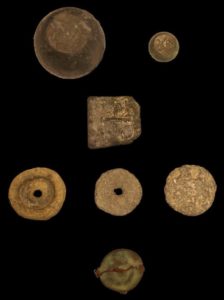 Archaeological experts
from the University of Alicante in Spain have recently identified the first Byzantine monastery ever found on the Iberian peninsula.
Archaeological experts
from the University of Alicante in Spain have recently identified the first Byzantine monastery ever found on the Iberian peninsula.
They first came across several round metal objects at the archaeological site, which is located in the area of Elda, Alicante. The exact identification of these objects had proven to be a mystery since the 19th century.
In the 6th century, Emperor Justinian forced people to keep a cache of state-minted coins in the main churches of each city. In this way, merchants could show that the coinage they used in economic transactions corresponded with the official money that the Emperor had minted.
The churches used to work as guarantors that buyers of precious metals were not cheated and that the coins in general use had the actual value that they were meant to have. If the operations were fraudulent, the tax revenue was lower — something the Emperor kept close tabs on.
"This apparently is how the monastery of "El Monastil" functioned as a Byzantine administrative and fiscal headquarters by order of the emperor," explains Antonio Manuel Poveda, a professor of Ancient History and director of the Archaeological Museum of Elda.
To read the complete article, see:
First Byzantine Monastery Discovered in Spain
(https://eu.greekreporter.com/2020/01/22/first-byzantine-monastery-discovered-in-spain/)
ANCIENT COIN GIVEN TO PUTIN
This article from the Jewish Press describes an ancient coin given to Russia's Vladimir Putin. -Editor
Russian President Vladimir Putin received on Thursday from a 2,000-year coin uncovered in Jerusalem at the City of David excavations.
Putin is in Israel together with 45 global leaders and royals to attend the Fifth World Holocaust Forum at the Yad Vashem Holocaust memorial and to mark the 75th anniversary of the liberation of Auschwitz-Birkenau.
Putin was awarded the coin by Jerusalem's Mayor Moshe Leon, with Prime Minister Benjamin Netanyahu in attendance, on the sidelines of a dedication ceremony of the monument in memory of the heroism of the soldiers and residents who were killed during the siege of Leningrad in World War II.
The coin is an original, inscribed with the ancient Hebrew words "Liberty of Zion." On the other side of the coin are the words "year two" and refer to the second year of the Great Revolt during the years 66–73 CE.
The coin was minted by Jewish rebels in Jerusalem on the eve of the destruction of the Second Temple in 70 CE by Rome's 10th Legion.
Coins that were minted in the second and third years of the revolt are plentiful and easier to find, but coins from the fourth year are much rarer.
To read the complete article, see:
Putin Receives 2,000-Year-Old Coin Uncovered in Jerusalem
(https://www.jewishpress.com/news/israel/putin-receives-2000-year-old-coin-uncovered-in-jerusalem/2020/01/23/)
SWISSMINT SELLS OUT OF SMALLEST COIN
Nothing grabs attention better than superlatives. That first sentence may be a lie, but who wants to read about the third best this or the seventh largest that? News stories thst grow legs and spread often have headlines touting the first-ever or largest-ever whatever. This week in numismatics the story with legs was headlined "World's smallest coin". To prove the point, before I had a chance to share the story, Numismatic News reported on Saturday that the issue had already sold out.
Here's an excerpt from just one of the articles (Daily Mail) going around about this neat little Swiss coin. -Editor
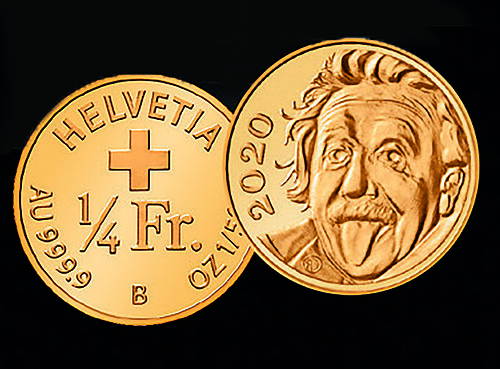
Switzerland has minted a gold coin so small that a magnifying glass is needed to see each side - one of which shows Albert Einstein sticking out his tongue.
State-owned Swissmint said that the 0.12-inches (2.96-millimetre) gold coin is the smallest in the world. It is similar in size to the combined thickness of two pieces of paper.
The coin weighs just 1/500th of an ounce (0.063 grams) and has a nominal value of 1/4 Swiss francs (about 20p). Its weight is comparable to that of two grains of rice.
Swissmint said the coin, of which just 999 have been made, will be sold for 199 francs (£155) with a special magnifying glass so owners can see the famous physicist on its face.
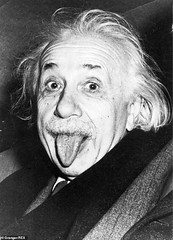 The famous image of Einstein sticking out his tongue was taken on
his 72nd birthday on March 14, 1951.
The famous image of Einstein sticking out his tongue was taken on
his 72nd birthday on March 14, 1951.
United Press photographer Arthur Sasse was trying to persuade him to smile for the camera, but having smiled for photographers many times that day, the scientist stuck out his tongue instead.
Swissmint said it wanted to push boundaries with the coin and stretch the limits of technology and achieve something unique.
Einstein lived mainly in Switzerland from 1895 to 1914, where he also completed his studies in 1900, at today's ETH in Zurich.
To read the Numismatic News article, see:
Smallest Gold Coin in the World Sold Out
(https://www.numismaticnews.net/article/smallest-gold-coin-in-the-world-sold-out)
Thanks to readers Dick Hanscom, Chip Howell, Aaron Oppenheim, David Pickup and others for passing this along. -Editor
To read other articles, see:
Switzerland unveils world's smallest coin
measuring 0.12 inches, weighing one 500th of an ounce and showing Albert Einstein sticking out his tongue (if you've got a magnifying glass!)
(https://www.dailymail.co.uk/news/article-7920215/Switzerland-unveils-worlds-smallest-coin-measuring-0-12-inches-weighing-one-500th-ounce.html)
Albert Einstein coin is the smallest of its kind
(https://www.foxnews.com/world/albert-einstein-coin-smallest-of-its-kind)
Switzerland Mints World's Smallest Gold Coin
(https://www.snopes.com/ap/2020/01/23/switzerland-mints-worlds-smallest-gold-coin/)
BRITAIN'S NEW BREXIT 50P COIN
In the we-promise-it's-happening-for-real-this-time-department, David Sundman passed along this article from The Sunday Times about Britain's new Brexit commemorative 50p coin. Thanks. Thanks also to David Pickup and Dick Hanscom for forwarding a BBC News article. -Editor
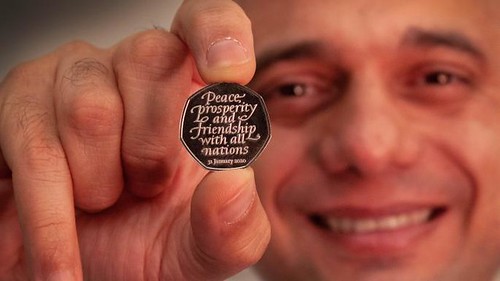
A new commemorative 50p coin to mark Britain's departure from the European Union is inscribed with a phrase inspired by an American president.
Sajid Javid, the chancellor, originally ordered production of the celebratory coins in advance of the original departure date of October 31.
But the Brexit delay meant about a million coins had to be melted down and the metal — gold, silver and cupronickel — saved until a new exit date was confirmed.
Today the chancellor has unveiled a new coin bearing the date January 31 and the inscription "Peace, prosperity and friendship with all nations."
The words echo a famous quote from the first inaugural address of Thomas Jefferson, a driving force behind American independence, and the third president of the United States.
About three million Brexit coins will enter circulation around the UK from Friday — the day the UK leaves the EU —with a further seven million to be added later in the year.
As part of the launch of the coin, the Royal Mint will open its doors for 24 hours to let people strike their own commemorative Brexit coins.
Javid, who is Master of the Mint, was given the first batch of coins, and will present one to Boris Johnson.
To read the complete articles, see:
Brexit 50p coins quote American founding father
(https://www.thetimes.co.uk/article/brexit-50p-coins-quote-american-founding-father-wf0cs8ldj)
Brexit day 50p coin unveiled by Chancellor Sajid Javid (https://www.bbc.com/news/uk-politics-51250753)
THE VALUE OF HANDWRITTEN NOTES ON BANKNOTES
Currency Specialist Brad Ciociola wrote in his Stack's Bowers blog about an autographed 1891 $1 Silver Certificate. -Editor
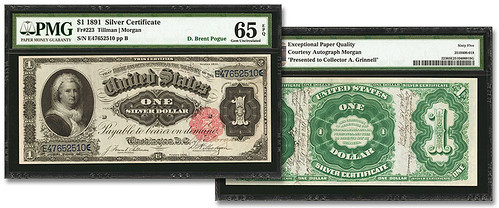
One of the fascinating notes we have encountered while cataloging the incredible D. Brent Pogue Collection of United States Paper Money is a Fr.223 1891 $1 "Martha Washington" Silver Certificate that was courtesy autographed by United States Treasurer Daniel Nash Morgan and presented by him to famed currency collector Albert A. Grinnell.
The note is graded Gem Uncirculated 65 EPQ by PMG. Morgan's signature appears above his engraved signature on the face of the note. However, the most fascinating part of this note is the inscription found on the back. Morgan went on to inscribe the back of the note Grinnell. The back inscription reads in part "Presented to Mr. Albert A. Grinnell Detroit, Michigan April 15, 1929."
Morgan goes on to list his treasurer title and dates of service and appointment. This is one of the most fascinating courtesy autographs as it ties in to one of the most famed names in the history of United States currency collecting. If Grinnell's massive currency collection were to be sold in today's market it would easily be the most valuable currency collection of all-time.
I scratched my head at the note's "Gem Uncirculated" grade, wondering how a note damaged by scribbling would not be downgraded. It's not just random scribbling of course, and to the right collector the inscription will enhance, not detract from the note's value. Value and grade are not the same thing, but the market conflates the two. The autograph is indeed mentioned on the holder - but on the back, not as an asterisk linked to the grade.
Anyway, a totally unrelated story I saw Sunday morning got me to thinking about other banknotes. A Washington Post article on the prosecution of Nazi war criminals quoted a cold memo from an SS leader enumerating the property stolen from Holocaust victims. Here's an excerpt. -Editor
The report included an accounting of the assets collected from the dead, worth 180 billion Reichsmark. Grand larceny on a massive scale, Black thought as he studied the numbers:
236 gold bars
Nearly 400,000 gold coins
2,134 silver bars
More than 60,000 watches
1,900 freight-car loads of textiles
Nearly 16,000 gold and diamond rings
1,716 pairs of gold earrings studded with diamonds
3,240 coin purses
Paper foreign currency from the United States, Canada, France, Brazil, Turkey, Switzerland, South Africa, Egypt, Argentina, Paraguay, Sweden, Palestine, Cuba, and Albania
My question is, can any of those looted banknotes be identified today? Were any captured from the Nazis at the end of the war? Are they stored in archives today? Do any of them bear autographs or notes from the victims? There's no telling if the banknote had been spent or stolen, but it would still be interesting if there were numismatic items bearing witness to the prior life of victims. -Editor
To read the complete articles, see:
Daniel Morgan Autographed $1 Martha Note to be Offered in March 2020 Pogue VI Sale
(https://www.stacksbowers.com/News/Pages/Blogs.aspx?ArticleID=daniel-morgan-note-pogue-sale)
The Nazis and the Trawniki Men
(https://www.washingtonpost.com/magazine/2020/01/23/how-department-justice-team-exposed-nazis-hiding-america/)
LOOSE CHANGE: JANUARY 26, 2020
Here are some additional items in the media this week that may be of interest. -Editor
The Lost Coins of Alexander the Great
Arthur Shippee passed along this BBC interactive investigation into the disappearance of a rare hoard of ancient coins: Treasure Hunters: the lost coins of Alexander the Great. Thanks. "This is an interactive 3D experience that uses audio. Please wear headphones." -Editor
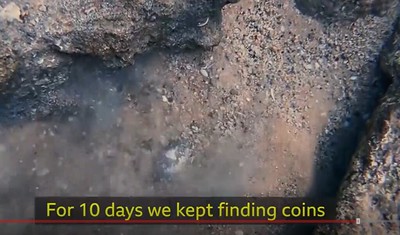
To read the complete article, see:
Treasure Hunters (https://www.bbc.co.uk/news/resources/idt-d4a6df1b-995d-4d0d-a562-43bd47b86afb)
Numismatist or Masochist? Searching for W Quarters
The Holyoke Enterprise published an article about a local man's search for W-mintmarked quarters. -Editor
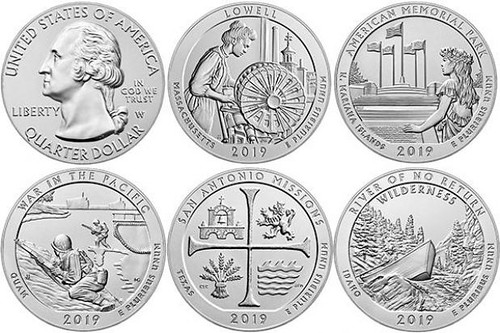
Find a quarter. Seriously, dig one out of your pocket, purse, glove compartment, whereever. Now look at the obverse side — that's the one with George Washington's head — for a small letter beneath "In God We Trust." Almost all of the quarters you come across day to day will have a P or a D. Those branch mintmarks tell whether a quarter was made in Philadelphia or Denver.
If your quarter is still shiny and new, it may have a W mintmark. If so, hold onto it; they're a rarity.
Only 10 million W quarters have ever been made, and they were all produced in 2019. By comparison, a combined 1.65 billion quarters were made in Denver and Philadelphia. Only 0.6% of last year's quarters were produced at West Point, and their purpose was to spur interest in numismatics.
One coin collector that took the bait was Holyoke's Jerry Brandt, who's spent an approximate 150 hours searching for W quarters. To date, he has 30 to show for his efforts.
To read the complete article, see:
NUMISMATIST OR MASOCHIST? (https://www.holyokeenterprise.com/local/numismatist-or-masochist)
PEPSI POINTS, REAL MONEY AMD A HARRIER JET
Here's a fun article on the time someone tried to buy a jet plane using Pepsi points. -Editor
 In 1995 Pepsi ran a promotion where people could collect Pepsi Points
and then trade them in for Pepsi Stuff. A T-shirt was 75 points, sunglasses were 175 points, and there was even a leather jacket for 1,450 points. Wearing all three at once would get you some serious
1990s points.
In 1995 Pepsi ran a promotion where people could collect Pepsi Points
and then trade them in for Pepsi Stuff. A T-shirt was 75 points, sunglasses were 175 points, and there was even a leather jacket for 1,450 points. Wearing all three at once would get you some serious
1990s points.
The TV commercial where they advertised the points-for-stuff concept featured someone doing exactly that.
But the people making the commercial wanted to end it on some zany bit of "classic Pepsi" craziness. So wearing the T-shirt, shades, and leather jacket, the ad protagonist flies his Harrier Jet to school. Apparently, this military aircraft could be yours for 7 million Pepsi Points.
The joke is simple enough: they took the idea behind Pepsi Points and extrapolated it until it was ridiculous. Solid comedy writing. But then they seemingly didn't do the math. Seven million sure does sound like a big number, but I don't think the team creating the ad bothered to run the numbers and check that it was definitely big enough.
But someone else did. At the time, each AV-8 Harrier II Jump Jet brought into action cost the United States Marine Corps over $20 million and, thankfully, there is a simple way to convert between USD and PP: Pepsi would let anyone buy additional points for 10 cents each. Now, I'm not familiar with the market for second-hand military aircraft, but a price of $700,000 on a $20 million aircraft sounds like a good investment. As it did to John Leonard, who tried to cash in on this.
And it was not just a lame "tried." He went all in. The promotion required that people claimed their prizes with an original order form from the Pepsi Stuff catalog, traded a minimum of 15 original Pepsi Points, and included a check to cover the cost of any additional points required, plus $10 for shipping and handling. John did all of that. He used an original form, he collected 15 points from Pepsi products, and he put $700,008.50 into escrow with his attorneys to back the check. The guy actually raised the money! He was serious.
To read the complete article, see:
When a Man Took a Joke in a Pepsi Ad Seriously, Chaos Ensued
(https://lithub.com/when-a-man-took-a-joke-in-a-pepsi-ad-seriously-chaos-ensued/)

